[email protected] | +503 7632 0969 |
Register / access | wish list.

- Agritourism
- Archeology and History
- Community Tourism
- Cultural Diversity
- Sun and Beach
- World Heritage
- El Salvador
- Central America Nature
- Celebrations
- Archaeology and History
- Central America, Adventure
- Digital Nomads
- Learning Spanish
- Romanticism in Central America
- Incentives and Business
- Interactive Map
- Scuba diving
- Download APP
- Visas and emergencies
- Health information
- Flying to Central America
- How to travel
- Currencies in Central America
- Tour Operators
- Travel requirements to enter CA+DR
- Information for wholesalers
- 6 – 9 days
- 10 – 13 days
- 14 – 18 days

THE FIRST SPANISH CITY OF HONDURAS
Tela was founded in 1534 and declared a municipality in 1876. Yet, Tela thrived due to the banana activity with the installation of the Tela Rail Road Co . in what is now the Villas Telamar hotel complex, where you can still appreciate the type of architecture introduced by the company.
Tela is located in the bay bearing the same name, and framed by the Jeannette Kawas Park , where you will find the Túnel del Amor or Tunnel of Love ; Puerto Escondido or Laguna Azul ; and, Punta Izopo , with vegetation very typical of these coastal areas. Tela is surrounded by Garífuna communities that came from Punta Gorda in Roatán , where we now find the community of Triunfo de la Cruz . During this time, Doctor Wilson Popenoe started what is now the Lancetilla Botanical Garden , becoming the second most important botanical garden in the continent, since it houses tropical plants from all over the planet.
Sub-aquatic research was recently conducted in front of the community of San Juan to verify the presence of an elkhorn reef bank, and according to the studies, its status was rated as very good.
The Cusuco National Park is a beautiful natural space rich in biodiversity. Very close to the city, the park is located on the slopes of the Sierra del Merendón . Two hundred and seventy species of birds, 93 species of reptiles and amphibians, 35 species of bats, and a large number of mammal species have been monitored. You must not miss this.
Tela offers Garifuna communities, white sand beaches, and a variety of hotels, restaurants, and hidden places where nature can be appreciated, while you rest on a virgin and quiet beach.
GEOPOSITION
Useful information - Don't leave anything
Contact information.
OTHER PLACES OF INTEREST THAT MAY INTEREST YOU
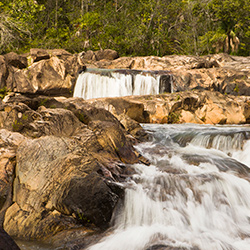
Rio on Pools
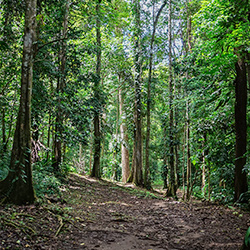
Puerto Viejo de Talamanca and Cahuita
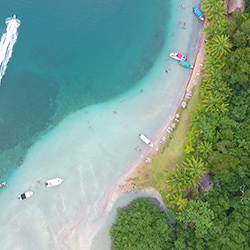
Starfish Beach
OTHER WAYS TO LIVE CENTRAL AMERICA
RECOMMENDED TOURS
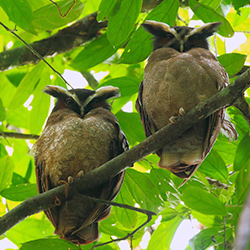
All Luxury Jungle
Enjoy Honduras and Belize with luxury accommodations and activities, discovering Mayan ruins, and natural parks.
HISTORY AND MYSTICISM
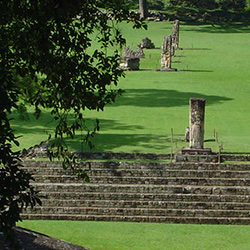
Mayans and Surf City
The history and mysticism of Guatemala, Honduras, El Salvador, and Nicaragua in this tour loaded with culture and nature in Central America.
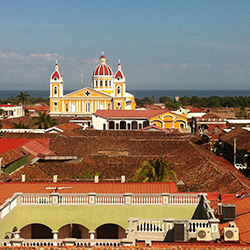
Grayline Costa Rica and Nicaragua
The culture and the nature surround you in this tour across Costa Rica and Nicaragua. It knows the most emblematic places and enjoys the North Pacific Ocean.
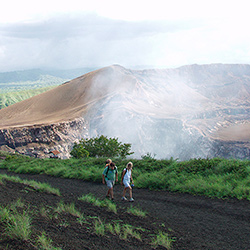
Colorful Central America
Travel Central America from North to South
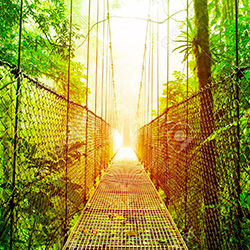
On the Pan-American Highway Through Central America
An exceptional trip It covers 5 Central American countries from north to south.
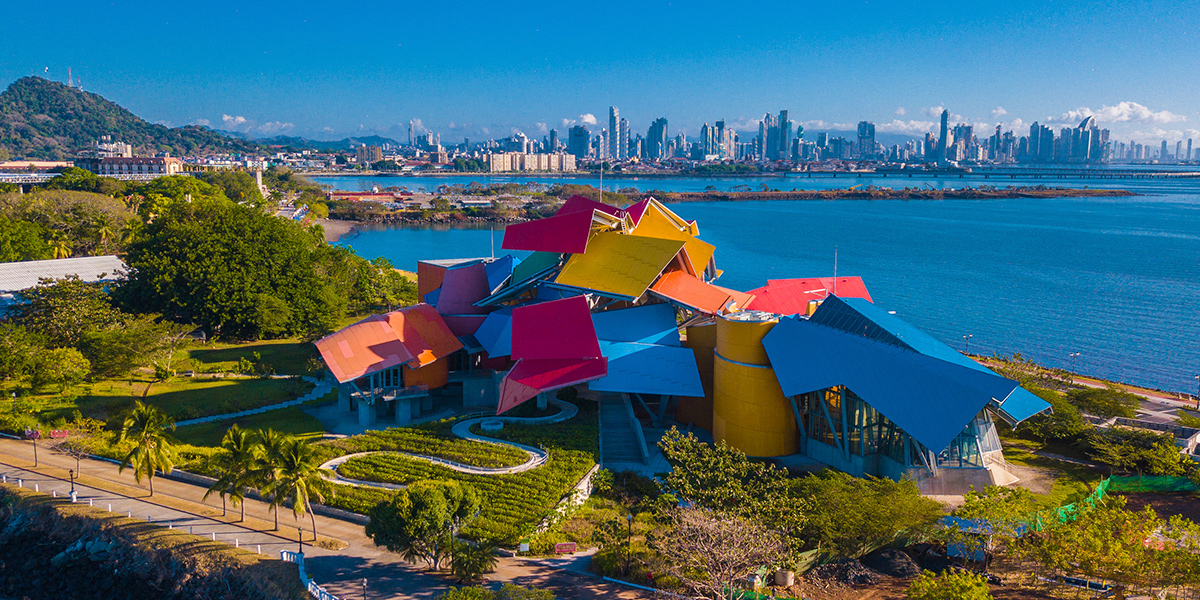
Panchimalco
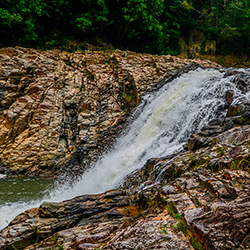
Mountain Pine Ridge
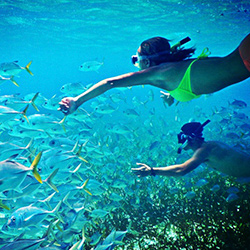
Belize and Guatemala II
Enjoy the best all-inclusive hotels in Guatemala and Belize.
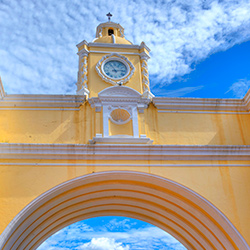
Mayan Triangle
On this tour, you will visit the most important Mayan remains of Central America: Joya de Cerén, Tazumal, Casablanca, Copán, and Quiriguá.
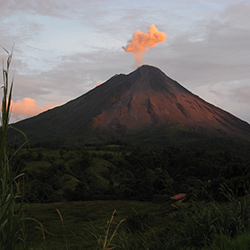
Costa Rica – Nicaragua: Forests, Volcanoes and Colonial Cities
Hike through the forest, fly through the trees, visit impressive colonial cities, and admire active volcanoes...feel a thousand sensations
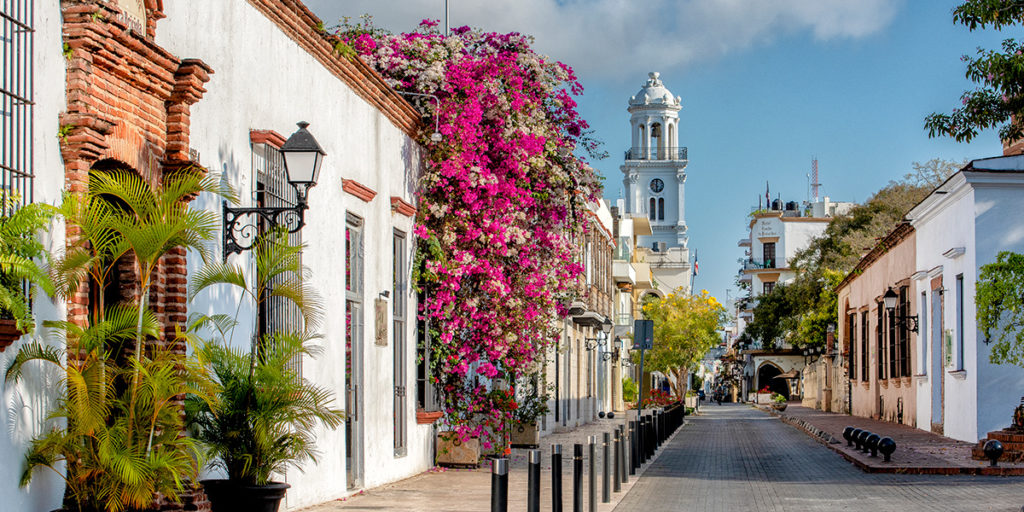
The Best of Central America and the Dominican Republic
Combina las riquezas naturales, culturales y gastronómicas, además de la aventura, la calidez de su gente y algunas de las zonas más populares de República Dominicana, Nicaragua, Panamá y Costa Rica.
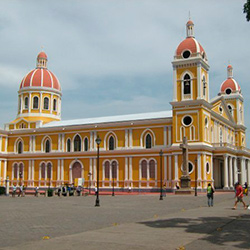
Colonial, colorful and traditional
Enjoy Nicaragua, El Salvador, and Honduras natural wonders, cultural richness, and Mayan archaeology.
Central America Get to know the places, spaces, and monuments that make up Central America.
Live Central America! Enjoy Central America!
- What to see
Register Sign up and enjoy private area with wish list
CONTACT Write us. Travel without doubts. [email protected]
Call us +503 7016 4711 FB Messenger Visit Centroamérica

© Legal Notice - Privacy Policy

Regístrate y disfruta de zona privada con lista de deseos
Acceder a zona privada
Expedia Rewards is now One Key™

Enjoy a piece of paradise at Tela, a scenic, laid-back beach town on the north shore of Honduras. This area offers some of the country’s best beaches and fantastic scuba diving. You can also tour the national park and admire the gardens.
Head to the sandy beaches and see the blue Caribbean on one side and thick rows of coconut trees on the other. Between Palm Sunday and Easter, tens of thousands of revelers flock here to party on the beach. However, for the rest of the year, it is fairly quiet.
Delve into the blue Caribbean waters with a scuba dive. The dive center, located in the Bay of Tela, offers diving courses and tours for all levels. See the brilliant creatures of Capiro Reef, one of the Caribbean’s healthiest reef ecosystems, right before your eyes. Try snorkeling at the charming island of Cayos Cochinos.
Explore Jeanette Kawas National Park, one of the largest protected areas in Honduras. Formerly known as Punta Sol National Park, it was renamed in 1995 to honor environmental activist Jeanette Kawas, who was murdered for her efforts to keep palm plantations out of the area. Today, it is a testament to her hard work. See a huge variety of water and land animals, from howler monkeys to dolphins. The park is home to 14 different ecosystems, including rainforest, mangroves and lagoons.
Visit Lancetilla Botanical Garden, one of the largest botanical gardens in the world. Located just outside of Tela, the garden is spread over 4,150 acres (1,680 hectares) and is home to over 1,000 species of plants from four continents. Follow the walking trails that wind through the garden and arboretum.
Tela is a 90-minute drive from San Pedro Sula, the second-largest city in Honduras. Tela is also a 90-minute drive from La Ceiba, a port city famous for its nightlife. From there, take a ferry to the tranquil island of Utila.
Where to stay in Tela

Barrio El Centro
While visiting Barrio El Centro, you might make a stop by sights like Municipal Market and Central Park.
- Tela Hotel Deals
- Vacation Rentals in Tela

Reviewed on Jun 12, 2024

Reviewed on Jun 18, 2024

Reviewed on May 31, 2024

Reviewed on Aug 8, 2023

Reviewed on Nov 5, 2023

Reviewed on Apr 13, 2024
Check Tela hotel availability
Popular places to visit.
If a restful vacation is part of your travel plans, Tela Beach might be the perfect place to seek out during your trip to Tela. Wander the parks or discover the area's coral reefs.
- Lancetilla Botanical Garden & Research Center
Explore the great outdoors at Lancetilla Botanical Garden & Research Center, a lovely green space in Tela. Wander the beaches or discover the area's coral reefs.
- Municipal Market
You can enjoy retail therapy at Municipal Market during your stay in Tela. Wander the beaches and forest while you're in the area.
Reviews of Tela
The city is overall safe to hang out.
beautiful beaches
Resort is in a great location, bring bug spray as there are lots of sand fleas!
5/5 - Excellent
the beach is so clean, and the place is really quiet
I like tela this place is very different from the other resorts in the area and basically has no amenities except wifi. It is a beautiful place but be prepaired to bring all your own food and drinks if it is off season.
2/5 - Disappointing
Tela isnt worth the stop not much to do and really not clean
- Cities near Tela
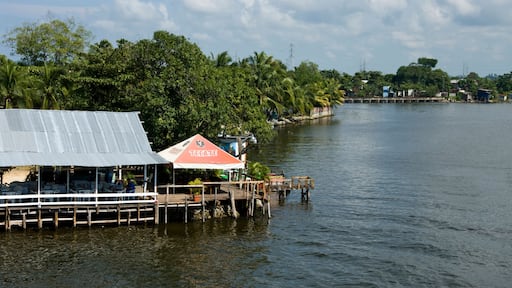
Puerto Cortés
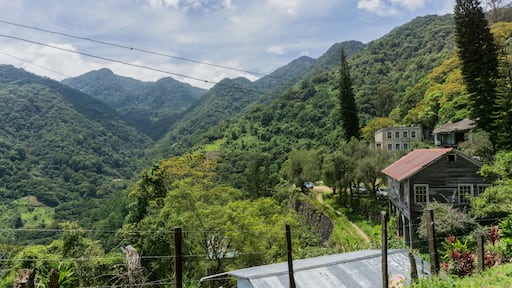
- Places of interest
- Jeanette Kawas National Park
- Central Park
- Puerto Cortés Central Park
- Coca Cola Beach
- Pico Bonito National Park
- San Fernando Fortress
- Cienaguita Beach
- El Faro Beach
- San Ignacio Ecological Park
- Punta Izopo National Park
- Río Jilamito
- 2024 Sexiest Men Of the Moment
- Of The Essence
- Celebrity News
- If Not For My Girls
- The State Of R&B
- Time Of Essence
- SSENSE X ESSENCE
- 2023 Best In Black Fashion Awards
- 2023 Fashion House
- Fashion News
- Accessories
- 2024 Best In Beauty Awards
- Girls United: Beautiful Possibilities
- 2024 Travel Awards
- Relationships
- Bridal Bliss
- Lifestyle News
- Health & Wellness
- ESSENCE Eats
- Food & Drink
- Money & Career
- Latest News
- Black Futures
- Paint The Polls Black
- Essence Holiday Gift Guide 2023
- 2024 Black Women In Hollywood
- 2024 ESSENCE Hollywood House
- 2024 ESSENCE Film Festival
- 2024 ESSENCE Festival Of Culture
- 2023 Wellness House
- 2023 Black Women In Hollywood
- Girls United
Visit For The Culture and The Food: A Guide to Tela, Honduras’ Afro-Caribbean Community
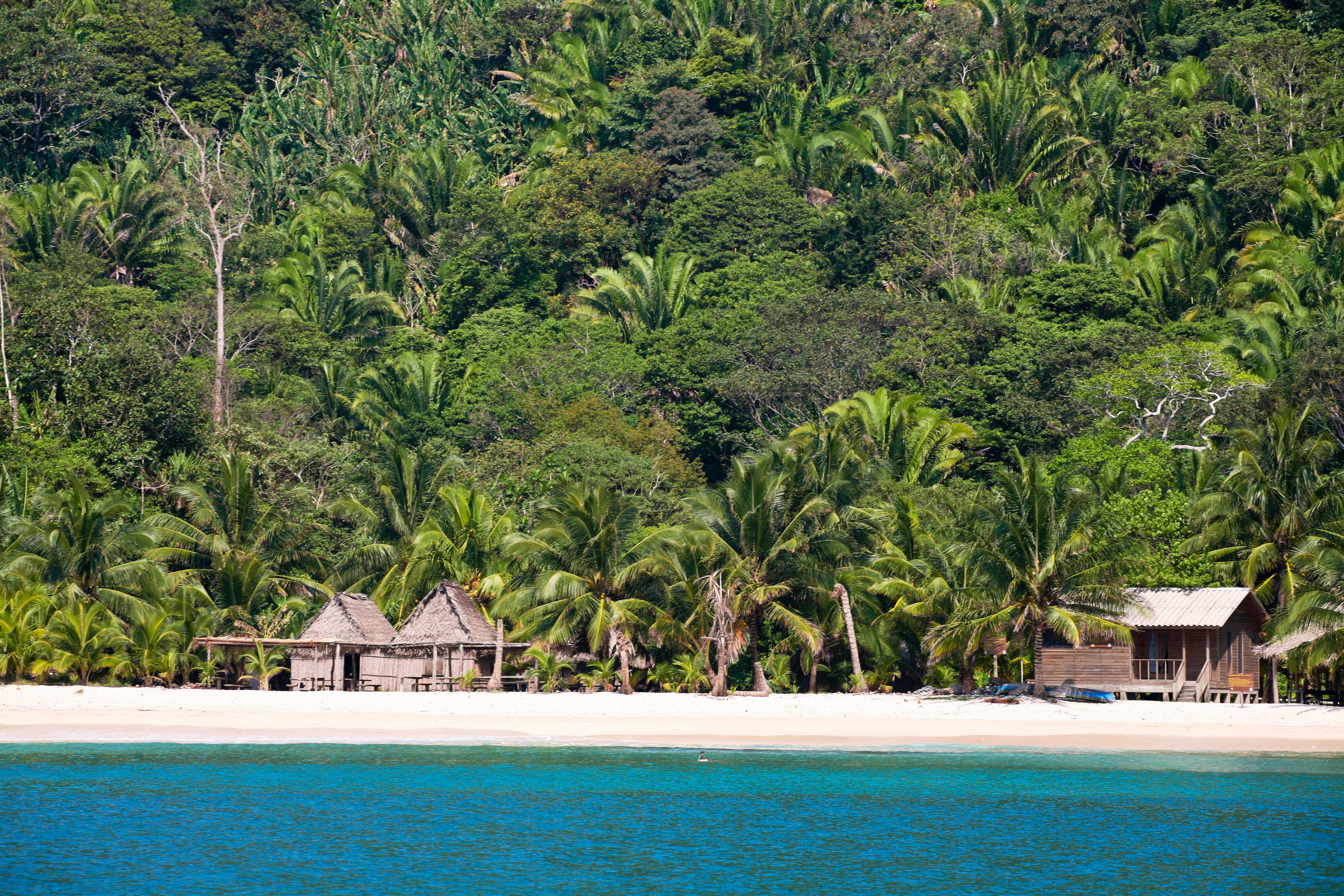
The tranquil region of Tela, located in Honduras’ northern Caribbean coast, is an hour and a half drive away from the closest international airport, San Pedro Sula Airport (SAP). It is in this tucked-away community that you will find the roots of Honduras’ Afro-Caribbean Garifuna.
Black people living on St. Vincent in the 17th century were exiled by British troops in 1796 and eventually shipped off to the Honduran island of Roatan as well as to the coastal areas of Honduras and Central America. The Garifunas are a mixture of African and native descent with their own language, art, and customs, and have utilized their coastal refuge to become a largely seafaring community. In the destination, there are a plethora of marine-based tours like scuba diving amongst endangered species of coral, snorkeling next to hawksbill turtles, and kayaking through mangroves–all easily found just off the coast home to 100,000 people.
Taste the Tradition
Some of the traditional Garifuna food that you can try in the region include Sopa de Pescado (fish soup comprised of yucca, onion, and coconut milk), Machucha (a ball of yellow and green plantain served with soup), and Bimecacule (sticky sweet rice). “Garifuna” literally means cassava-eating people, and as you could guess, cassava is the main staple used in their cuisine. For example, the tasty Ereba is cassava bread made from the root of the yucca plant.
Garifuna Fishing
Adjacent to the only major resort in the destination, the Indura Beach & Golf Resort , are the Miami and Tornabe Garifuna villages. The pastel colored community of homes marks the traditional home building style of the Garifuna. The men sit outside and weave cream-colored nets in a rapid-fire method that has been passed down for centuries. For example, local Garifuna net weaver, Amado Diego Martinez is one of the few fishermen left in Tornabé that follows the generation-old technique. Martinez manufactures the tools he uses to weave the nets, which consist of a wood needle and a “mayero” of different sizes- vary from two inches to seven inches wide, depending on the size of fish that the fisherman needs to catch.
The fishing process usually involves three men standing a few feet from the coast in the water holding specific ends of the net. One person creates a large semi-circle and two men throw the net, not missing a beat. The crew pulls and pulls, the net slowly comes together, collecting fish along the way. The most common fish caught by local fishermen in Tela are Jurel (yellowtail), bonito (tuna), culila (similar to jurel), macarela (mackerel), calale (lane snapper), and Corvina (similar to sea bass).
Eco-Excursions
If you’re keen to explore your surroundings, guided kayak tours through Tela’s ancient mangrove forests offer another opportunity to become immersed in the rich, biodiverse environment of the Jeannette Kawas National Park in which Tela sits. The “Laguna los Micos” itinerary led by the Garifuna Tours company showcases the wealth of species that call the country’s second largest lagoon home. Possible sightings include white-faced monkeys or ‘micos’ which frequent the mangroves, as well as a plethora of birdwatching opportunities with some of the 350 species of birds that migrate and nest there.
Protected Gardens
Three miles south of Tela, the Lancetilla Botanical Garden and Research Center is the only the Botanical Garden in Honduras and one of the largest in Latin America. It was founded in 1925 to test the adaptability and marketability of plantain and currently boasts a total of 1681 hectares. Walking through the garden will unfold a diverse collection of national and exotic flora, collected over the last 80 years from tropical areas around the world, including orchids, palms, mangoes, bamboos are also represented, as well as the largest plantation of purple mangosteen in the western hemisphere.
Beneath the Deep Blue
Tela is outfitted with only one quiet dive shop (compared to over 100 on the nearby island of Roatán). The Tela Marine dive shop and educational center were started by Honduras-born Hungarian, Antal Borcsok. His PADI -certified instructors takes small groups to dive locations teeming with marine life and healthy coral like Mushroom Mound, Canyon, and Rotunda.
For those who’d rather not dive so deep, snorkeling at Punta Sal is offers a chance to see the highest density of critically endangered elkhorn coral in the Caribbean. The snorkeling excursion also includes a visit to the Punta Sal National Park and access to Punta Sal’s private beach.

Tela, Honduras: Exploring Punta Sal
- April 12, 2015
- Beach Breaks , Honduras , Wildlife & Nature
- Comments Off on Tela, Honduras: Exploring Punta Sal
Discovering paradise with Garifuna Tours
Gorgeous stretches of tan sand. Stunning, perfectly placed leafy palms. Turquoise and emerald waters lapping onto the shore. Monkeys bounding from tree to tree overhead. Landscape that looks like a blend of Caribbean perfection with a drop of Southeast Asia from the rugged outcroppings.
I felt like I was transported to a paradisiacal wonderland where the water was fresher, the colors were brighter, and time passed more slowly. And even more unbelievably, the four of us were the only people exploring this untouched haven. Where does this happen?!
This is Punta Sal, a slice of Tela that blends beachy wonders, dramatic landscape, and untouched jungle, and it’s quite possibly one of the most beautiful places on earth.

The area is home to the Garifuna population, an indigenous community that is culturally far more Caribbean than it is Central American. The tour company that we chose to help guide us for the day, Garifuna Tours, shares the indigenous group’s name. There are a slew of tours that the company offers within Honduras but Punta Sal was at the top of our list. We had gotten a fair dose of adventure between our days at Pulhapanzak plus our experience ‘extreme spelunking’ at Taulabe Caves . What we wanted for our final excursion was something that would blend an outdoor experience with an opportunity to marinate a bit, just soaking up our surroundings during one of our final days. Punta Sal did just that.
We debated – do we opt for the more expensive private tour so we can guarantee it’ll be just the four of us, or just book online through their normal portal for $36 per person. The private tour was more than twice as much, and while it still represented a decent value we didn’t think it was necessary. If there were others on the trip that wouldn’t be such a bad thing anyway. Half the fun of travel is meeting other travelers, right?
Ultimately it ended up just being the four of us on the trip anyway. We met at around 8AM at the Garifuna Tours office in Tela and jumped in a van with our tour guide, Darren, a Honduran who had spent a number of years in the States. Unlike our previous journeys with Spanish-speaking guides, Darren spoke English which made everything extra simple. Our first stop on this day long adventure was the jungle, where the tour would begin.
The Jungle // Jeanette Kawas National Park
In most places this beautiful and this well-maintained, you’d be lining up to walk through and glimpse the beauty. We were entering a slice of Jeanette Kawas National Park, a protected area named after the female environmental activist who worked to ensure the preservation of flora and fauna in the area. Here, we were the only people, following as Darren led us through the jungle. He warned of jaguars who had made a couple of appearances and when we ooh ed and ahh ed over the monkey that seemed to greet us, he advised that the monkeys would probably follow us around for the duration of our journey.
He was right.

When we went to the Amazon, we were prepared. Long pants, long-sleeved shirts, tennis shoes, hats, a bug repellent bath, etc. Here, we couldn’t help but laugh at how poorly dressed we were for the environment. I was wearing a bathing suit with cut off shorts, a coverup tank, and flip-flops, and everyone else was wearing some rendition of the same. Still, it wasn’t too strenuous of a walk so it wasn’t a major issue, and luckily I’d brought along a travel-sized insect repellent that we all found ourselves using immediately.
As you can probably tell from the photos, monkeys were the highlight for me. It’s not every day that monkeys walk in step with you, and we were in awe watching them up close and personal in their natural habitat, especially with no one else around. We encountered a few larger-than-life spiders that would normally have had me running for the hills, and we each ate a termite to see what they tasted like (for the record, they taste like carrots and herbs mixed together, and they make your tongue a bit numb). We saw huge, vibrantly colored butterflies, and trees that mimicked what we’d seen in the Peruvian Amazon a couple of years back (some covered with thousands of thick thorns, similar to the one that poisoned Scott ; plus trees with gorgeously thick trunks that spew red ‘blood’ when they’re hacked).
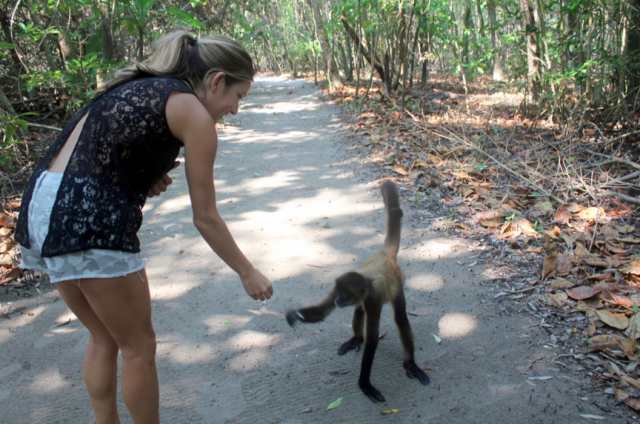
After we’d made it through the thick brush, we reached a beach, the spot that was used as a hideout by Captain Morgan during pirating days in the region. Now, it’s much more benign; a gorgeous conch shaped stretch of sand lined with trees and brushed by extra calm, protected waters. Garifuna Tours had it well thought out. Instead of trekking back the way that we came, our boat was waiting for us here to jet us off to our next destination.
It was stunning, plain and simple. The old adage, a picture is worth a thousand words ? That’s no truer than instances like this where words can’t quite capture the je ne se quois of an experience.

Punta Sal, Honduras from Shannon Falzon on Vimeo .

We made a quick pit stop to snorkel through the Lover’s Cave, where visitors are meant to make a love wish while they make their way through. From there, we let the wind and sun dry us off as we rode over to our final destination, a beach with a perfectly placed hammock where locals serve up huge plates of local fare: fried whole fish, rice and beans, and plantains accompanied by an ice-cold Salva Vida.
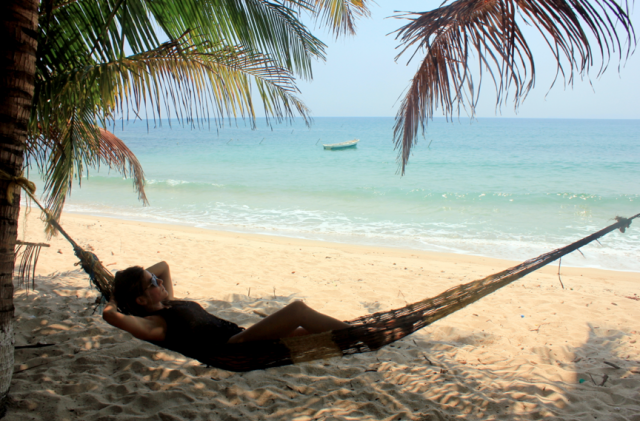
We were astounded by the natural beauty of the area. The beach juxtaposed with the gorgeous wild landscape is breathtakingly beautiful, and the fact that it’s not overrun with sun worshippers is especially enticing. We looked around and periodically popped into the sea to cool off, soaking it all in. There was one local family sitting on the beach when we arrived, charging their mobile devices with a solar-powered unit, and playing in the sand. I’m sure they’d agree: paradise found.
For anyone intrigued by Garifuna Tours , know that the company operates beyond the borders of Honduras, and their excursions span the majority of Central America, reaching into El Salvador, Guatemala, Nicaragua and Costa Rica. Our experience with Darren and the team in Tela was top-notch and they come highly recommended.
xo from Central America,

More about Shannon Kircher
Shannon Kircher is the founder and editor of The Wanderlust Effect. Founded in 2009, she has continued to document her international escapes as an expat in Europe and the Caribbean. Additionally, Shannon is the founder of Compass & Vine, a luxury boutique travel design firm, and is the Director of Marketing for the Frangipani Beach Resort. Shannon holds an MSc in Social Policy and Development from the London School of Economics and is a current candidate for WSET Level 3 in Wines & Spirits.
Related Posts

ITINERARY INSPIRATION: One Week in the Exumas
August 8, 2019

HOTEL INSIDER: A Stay at Grand Isle Resort, Great Exuma
August 19, 2019

Dodecanese Islands: Exploring Symi by Boat
May 29, 2018
- 1 Understand
- 2.1 By plane
- 3 Get around
- 5.1 Beaches
Tela is a city in Honduras . It is a sleepy coastal town of 100,000 people (2015) with nice beaches, in a region inhabited by the Afro-Caribbean communities called the Garifuna.

The Garifuna live on communally owned land around the area and have their own distinct language and culture. It has been slowly but surely working its way to becoming an important beach destination.
Tela has been the site of a pilot program aimed to create the Tourist Police. The result has been outstanding, with a force of 20 bilingual, friendly tourist police officers.
Less than 90 km east of San Pedro Sula 's international airport, and connected by an excellent paved highway, Tela is very easily reached from San Pedro Sula and El Progreso .
If you are driving your own car, the driving time is under one hour from San Pedro Sula.
If you are taking the public bus, the classiest option would be to choose Hedman Alas, a first class service coach operator that has non stop service from San Pedro Sula to Tela; otherwise, there are several companies offering comfortable direct non-stop buses to La Ceiba . A ticket from SPS to Tela should cost L100. Just let the driver know you wish to get off at the entrance to Tela. From this point, you can easily catch a taxi (L30/pp) to take you to the beaches, Tela's main attraction.

Once in Tela, like in most Honduran cities, the taxi services will provide a reliable way to get around. Also Tela is a great place to walk around and explore the beach and downtown areas.
A taxi from the town to the botanical gardens should cost L100 for two people.
- 15.78126 -87.45665 1 Museo Tela Railroad Company . Tu 08:00-16:30, W-Su 13:00-21:00, closed M . Tela used to be one of the main shipping areas for Bananas from the United Fruit Company. The term "banana republic" came from Honduras, when American and other fruit companies held great political sway. A rail service from the interior of the country brought produce to Tela to be shipped to the United States. Today the pier and train station that were central to that trade have been abandoned. They are within 90 m (100 yards) of the bridge in downtown Tela and are a great destination for any avid photographer. The pier is also a great adventure (not for small children). There you can see local fisherman trying there luck at the end of the pier. The best time to go is usually a weekend as the pier becomes a gathering point for many people, especially at sunset when the view is extraordinary. Part of the old railroad company building has been renovated as municipal offices, it is quite picturesque. ( updated Aug 2020 )
- 15.78447 -87.44794 2 Maya Vista Hotel , ☏ +504 24481497 . This hotel is on one of the highest points in the beach area and offers and amazing view of Tela from the observation deck on top of the Hotel. The Hotel also has a great eating area that offers a nice view as part of the dining experience. (Rooms here are ~ L1947). ( updated Aug 2020 )
- 15.9161 -87.6177 3 Parque Nacional Punta Sal ( Parque Nacional Jeanette Kawas ). 08:00-15:00 . Mangrove swamps, tropical forests, shady lagoons and coral reefs. Monkeys and bird watching. Hiking and snorkeling. Jeanette Kawas National Park renaming pertains to biologist who was murdered while trying to save lands from palm oil farming. ( updated Aug 2020 )
- 15.7406 -87.4564 4 Lancellita Botanical Garden , ☏ +504 94759685 . representative local botany and gardens. ( updated Aug 2020 )
- 15.8243 -87.3561 5 Parque Nacional Punta Izopo . more mangrove estuary-type topography along with beaches. Opportunities for kayaking, fishing, sightseeing. Little underdeveloped. ( updated Aug 2020 )
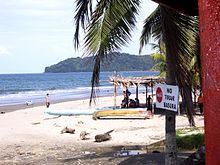
Go to the beach! Tela has a beautiful coastline, with tall palms, white sand, and exceedingly warm water. Make sure your belongings are watched at all times--either by you or a friend or family member--as unattended items can be taken by passing thieves. On the whole however, the beach experience is wonderful, and not to be missed.
- 15.7819 -87.4589 1 Muelle de Tela . Tela's well-known dock stands where its pier used to until it succumbed to storms. The beach on either side is right in front of the town. ( updated Aug 2020 )
- 15.818 -87.5583 2 Playa Miami Tela ( Miami Tela Beach ). ( updated Aug 2020 )
- 15.8986 -87.6266 3 Playa Cocalito . ( updated Aug 2020 )
Triunfo de la Cruz . For those looking for an off-the-beaten-path experience in Tela, a trip to the Garifuna community of Triunfo de la Cruz is a necessity. Located just a few miles up the beach from Tela, the area has not been invaded by the hotel industries. Small beach restaurants often have changing cabins, showers and beach shacks for tourists to relax. Some will even supply you with hammocks for your day of relaxation. A bus from the center bus station or a taxi are your best way to get to this area. Walking is not recommended. You could try Garifuna Tours (+504 24482904).
Tela's Garifuna community provides some of the best items to purchase in Tela. Strolling along the beach area, tourists will surely find people selling their hand made crafts and jewelry. Shell and shark tooth jewelry, coconut shell jewelry, and the more common hand woven jewelry, are the most prevalent items being sold.
A great purchase is the coconut bread or coconut candy (called 'tabla'). Women can be found carrying large buckets on their heads, which often contain the delicious baked goods.
One of the best restaurants in the area is a small pizza place right near the oceanfront bridge in downtown Tela. A new patio out back of the restaurant is right on an inner-coastal waterway, which enhance the dining experience. It also has a play area and swings for those traveling with young children. The pizza is affordable and delicious.
In addition, Hondurans say that the baleadas in the Tela and La Ceiba areas are the best in the country. A baleada is a thick tortilla with refried beans, avocados, scrambled eggs, fresh crema, butter and other ingredients such as chicken and sausage. They are fantastic.
A trip to Tela can not be completed with out trying the fresh seafood of the region. Sopa de Caracol (conch soup) and sopa de jaiba (crab soup) are well known treats in local restaurants. Locals have their opinions about which seafood restaurant is better, but they are not always the same. The people of Tela are very helpful (and use to wondering tourists) if you would like a recommendation.
Most hotels have their own restaurants, often inside of a secure compound for those that do not wish to walk around outside of the security of their hotels.
For the brave tourist, the Garifuna community will be happy share their homemade brew called Gifi (a coconut liquor).
For the more traditional experience, the beach front offers several bars. In addition most restaurants will have local beers and mixed drinks.
For those looking for a non-alcoholic beverage, a fresh, cold coconut will surely hit the spot. While at the main beach areas, someone will surely find you at some point and offer you a fresh coconut to drink from. It is part of the Tela experience and should at least be tried before leaving.
- 15.78937 -87.44338 1 La Ensenada Beach Resort & Convention Center , ☏ +504 24488400 . ( updated Aug 2020 )
- 15.78332 -87.44901 2 Hotel Bertha´s , Calle 8 . A budget hotel. Rooms are small but clean. ( updated Aug 2020 )
- 15.7803 -87.46394 3 Telamar Resort , ☏ +504 2480-4300 . A large resort with nice beaches, bars and a big pool with waterslides, plus entertainment. There are villas or a separate hotel building. This resort used to be the United Fruit Company's residential complex, so there are a lot of nice old bungalows from the 1900s. L 3573 . ( updated Aug 2020 )
- 15.81411 -87.40951 4 Caribbean Coral Inn , Triunfo de la Cruz ( Pickup from Tela upon request ), ☏ +504 669-0224 . Very welcoming family has a beautiful remote spot at the beach in the Garifuna village in Triunfo de la Cruz. The cabins are spacious, have private bathroom, fan, and sufficient seabreaze. An open space living room is available to guests. A small restaurant serves 4 daily fresh diners. The food is tasty. Continental breakfast is included with fresh juices, cereals, bread, tea. Within 40 min walk is the Ipozo reserve. Hotel can arrange a very good guide for L600. Recommended, better than staying in Tela. L838 + 16% taxes per night; each additional person is L222 +16% taxes per night .
- The Bay Islands . Take a yellow bus to La Ceiba , the launching point for ferries to Utila and Roatan . The 2½-hour bus ride leaves every half hour from the station near Calle 9 and Avenida 9, and costs L55. Be ready to leave Tela no later than noon, as the last ferry to the islands leaves at 16:00 and the ferry terminal is around a 30-minute taxi ride from the bus station.
- Has custom banner
- Has map markers
- Has Geo parameter
- Caribbean Honduras
- All destination articles
- Outline cities
- Outline articles
- City articles
- Pages with maps
Navigation menu

Honduras Travel Guide
Last Updated: September 1, 2023
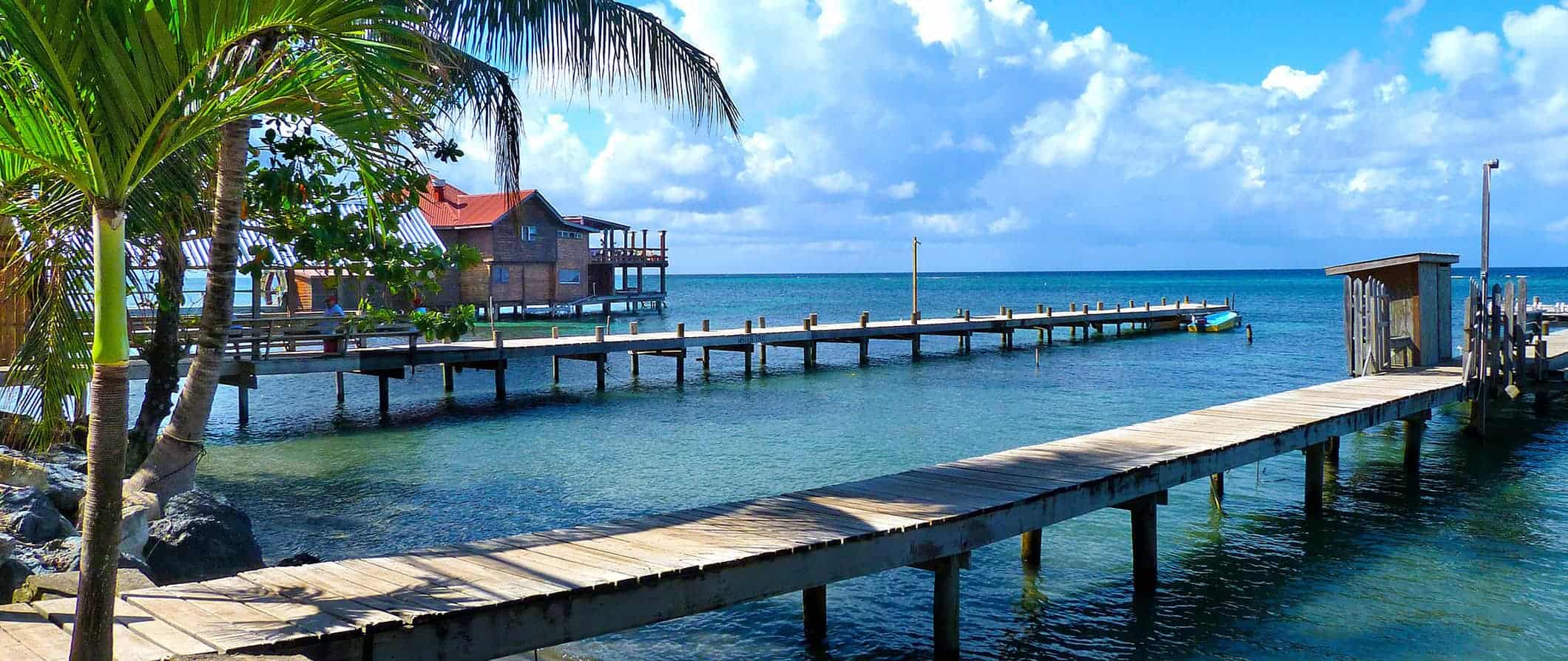
Unfortunately, owing to its violent past, it often gets glossed over for more polished Central American hotspots.
However, Honduras today is a much safer country and is popular with intrepid backpackers and expats looking to get off the beaten path. With world-class diving, a cheap cost of living, and incredible weather, Honduras offers some of the best value in the region.
That said, you’ll still need to take precautions and keep your wits about you — especially on the mainland — as crime and gang activity are still common.
This travel guide to Honduras can help you see the country, stay safe, and make the most of your visit to this beautiful and affordable country!
Table of Contents
- Things to See and Do
- Typical Costs
- Suggested Budget
- Money-Saving Tips
- Where to Stay
- How to Get Around
- How to Stay Safe
- Best Places to Book Your Trip
- Related Blogs on the Honduras
Top 5 Things to See and Do in the Honduras
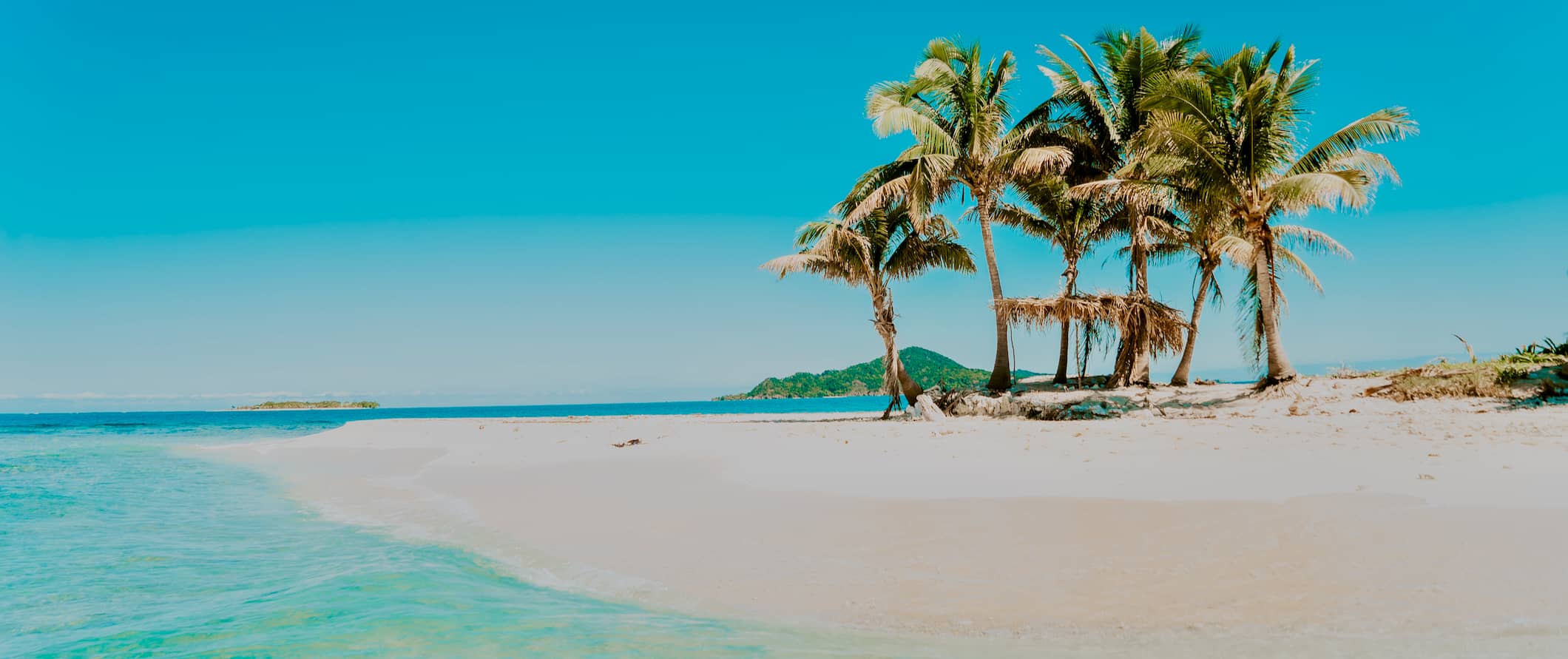
1. Explore the Copán Ruins
These incredible Mayan ruins are located near the border with Guatemala and are one of Honduras’ most popular tourist attractions. Nestled in a lush jungle valley, Copán Ruinas are a UNESCO World Heritage Site dating back to the height of the 5th century when Copán was a powerful capital of the Southern Maya kingdom. But in 738 CE, the king was captured and executed by his rival and archeologists believe that the city was abandoned by 800 CE. Today, the ruins attract tourists for their intricate stelae, tunnels, a hieroglyphic stairway, as well as the geography of the area itself which is filled with diverse wildlife including monkeys, sloths, parrots, and macaws. It takes a couple of days to see the entire site so try not to squeeze your visit into a day trip. There are two main sites: Copán, the main site originally used for nobility, and Las Sepulturas. To get there, head to the town of Copan Ruinas near the border with Guatemala; the ruins are nearby. Bring lots of sunscreen and water. Admission is 370 HNL.
2. Dive the Bay Islands
The Bay Islands, known as “Islas de la Bahía,” are one of the best diving spots in the Caribbean. They are located in the Gulf of Honduras and near the Belize Barrier Reef, which is part of the Mesoamerican Barrier Reef System. The Roatan, Utila, and Guanaja archipelagos all offer stunning dive sites with crystal-clear waters and incredible marine life. Roatan is the largest island while Utila is the cheapest, attracting budget divers as the island as it also offers a stunning array of wildlife, including nurse sharks, sea turtles, stingrays, and more. Get up close to colorful coral formations or deep dive 2,000 feet into the abyss for bluntnose sixgill shark sightings. Prices start at 870 HNL for one dive or a package of ten dives for 7,405 HNL.
3. Relax at Lake Yojoa
The country’s largest lake is rich in biodiversity with almost 400 bird species and over 100 plant species. This incredible site is a popular fishing spot for locals, a great place to visit a coffee plantation tour, and a fun place to zipline. Or if you’re looking for an adrenaline-filled experience, hike behind the stunning Pulhapanzak waterfall and explore the inside caves with the sound of water pounding around you. For something a bit more peaceful, rent a kayak and spend a few hours paddling around the lake. Or, if you don’t mind small spaces, head into the Caves of Taulabé where you can either explore on your own or hire a spelunking guide if you want to go deep underground. For a nice wander through the lush jungle wetlands, check out Los Naranjos Ecological and Archaeological Park. And if you’re up for a real challenge, hire a guide to climb to the top of Santa Barbara (2,744 meters/9,000 feet).
4. Adventure at Pico Bonito National Park
This sprawling bio-diverse national park is home to lush tropical jungles and moody cloud forests. It’s a haven for hiking, wildlife watching, and ziplining. The Cangrejal River is a fantastic place for white water rafting, with Class I-IV rapids. Or you can go swimming in the river and even jump off the rocks into the water if you feel like it. There are many different hiking trails here too, like the La Roca loop and the El Mapache trail to Bejuco Falls. If you’re a fan of the outdoors, don’t miss it. You can reach the park from La Ceiba or do it as a day trip from nearby regions.
5. Escape to Cayos Cochinos
The archipelago of Cayos Cochinos, made up of Cayo Menor and Cayo Grande, are two coral-abundant islands that offer some of the most postcard-perfect sandy white shorelines in Central America. They offer plentiful diving and snorkeling and the nearby cays are home to the world’s second-largest coral reef system. The only way to reach the Cochino Cays Marine Sanctuary is by boat; you can take a chartered day tour from Roatan and Utila or from La Ceiba. It’s a great place to disconnect and relax.
Other Things to See and Do in the Honduras
1. visit mercado guamilito.
Located in San Pedro Sula, this traditional market is an excellent place to buy Lenca ceramics, high-quality (and reasonably priced) leather, cigars, and silver. There’s also a no-frills food market that locals claim offers the best baleada , a national dish made with flour tortillas, cheese, cream, and fried beans. The market is open daily from 7am-4 pm.
2. Chill out on Utila
Most backpackers make a beeline for the island of Roatan, but if you’re looking for something beyond diving, Utila is a better option. It has a buzzing nightlife, cheap accommodation, beautiful white sand beaches, and even the chance to spot whale sharks. The 45-minute ferry ride from La Ceiba to Utila costs 750 HNL.
3. Visit Parque Nacional Jeannette Kawas
This national park is named after Jeannette Kawas, an environmental activist who fought to protect the area from commercial development and was brutally murdered in 1995. Now, her legacy lives on with this protected area, filled with abundant wildlife including howler monkeys, boa constrictors, and toucans. You’ll also find pristine beaches and untouched coral reefs here. The secluded park is also known as Punta Sal National Park and is just a 30-minute boat ride from Tela, a Caribbean coastal town. Admission is 120 HNL. Day trip prices start around 690 HNL.
4. Go zip lining
If you’re craving an adrenaline rush, Honduras has a dozen zip-lining experiences to choose from all around the country (including several on Roatan). Prices vary but expect to pay at least 950-1,085 HNL for a half-day tour. Lunch is usually included.
5. Explore the Río Plátano Biosphere Reserve
This heavily-forested area is a UNESCO World Heritage Site and one of the last remaining tropical rainforests in Central America. Established in 1982, it spans over 5,250 square kilometers (2,027 square miles) and is home to Mayan ruins, ancient petroglyphs, pumas, jaguars, giant ant-eaters, sloths, and over 2,000 indigenous locals. Getting here requires some effort (it’s a 6-hour bus from La Ceiba followed by a short boat ride) but you’ll be rewarded by sweeping vistas and a rare look at indigenous life in the rainforest. You can hire a day guide on arrival (for around 400 HNL) or embark on a multi-day tour up the river for 3,000 HNL. Kayaking day trips start around 940 HNL and crocodile night watching starts around 1200 HNL. Admission to the reserve itself is by donation.
6. Visit Valle de Angeles
This colonial town makes for a good day trip from Tegucigalpa, the capital of Honduras. It’s located 35 minutes away by car and, aside from the beautiful colonial buildings, there’s a lot of affordable handicraft shopping. While you’re here, spend some time relaxing in Parque Central, where you’ll see the historic colonial church or head into La Tigra, the nearby cloud forests that are full of hiking trails (admission is 247 HNL). Don’t forget insect repellent if you do visit the forest!
7. Attend Carnaval de La Ceiba
This is the biggest carnival in Central America. Held every May in La Ceiba, it attracts half a million revelers every year. The celebration is in honor of Saint Isidore the Laborer, the patron saint of the city. For two weeks, throngs of people flock to La Ceiba’s barrios (neighborhoods), who compete to throw the best carnavalito (little carnival) in town. It’s all in anticipation for the main event, the rainbow-filled parade “La Feria de San Isidro”, which takes place along Avenida San Isidro on the 3rd or 4th Saturday of May.
8. Go hiking in Parque Nacional Cusuco
This ethereal cloud forest is nestled into the Merendon mountain range near the border with Guatemala, making it somewhat difficult to access (during the rainy season you’ll need a 4×4). It’s a 2-3-hour drive from San Pedro. There are five stunning hiking trails that cross the cloud and dwarf forests. Expect to see plenty of parrots, toucans, and quetzals here. Unless you have a 4WD vehicle, you’ll need to go with a tour company. Admission is around 250 HNL.
9. See the Roatan Butterfly Garden
Located in Roatan, this indoor garden is home to over 30 species of moths and butterflies, as well as a large collection of boa constrictors, parrots, scarlet macaws, and tropical orchids. It is best to visit during the early morning when the butterflies are most active. Admission is around 358 HNL.
10. Visit the Lancetilla Botanical Garden
Located on the coast in Tela, Honduras’s only botanical garden happens to also be the largest in Latin America. Spanning over 4,100 acres, it boasts thousands of varieties of national and exotic flora and fauna (including a bamboo collection and an orchid collection). There are over 1,500 trees in its arboretum and the garden also has 3,000 acres of virgin rainforest. It’s open 365 days a year and admission is 198 HNL.
Honduras Travel Costs

Hostels – Shared dorms with 4-8 beds cost 370 HNL per night, with private rooms costing anything from 400 to 1,400 HNL. Free Wi-Fi and free breakfast are generally included. Most hostels also have A/C and hot water.
Wild camping isn’t recommended here due to petty theft, rainstorms, and the sweltering humidity. There are a few campgrounds around the country, though they aren’t any cheaper than staying in a hostel.
Budget hotels – Budget hotels can be found for around 1,000 HNL for a double room. Most of the cheaper hotels include Wi-Fi, however, for a hotel with a kitchen, A/C, and a pool you’ll pay at least 2,000 HNL per night.
Airbnb is available in Honduras but really only found in Tegucigalpa and the tourist spots on the coast. Prices start at 500 HNL for a shared room, 1,000 HNL for a private room, and 2,900 for a villa.
Food – Honduran cuisine leans heavily on fish, soups, beans, rice, and coconut. Popular dishes include guisado (a spicy chicken stew), carne asada (grilled sliced beef), and baleda (cheese and bean tortilla). Generally, you can expect a mix of Spanish, Lenca, and Caribbean influences.
Local meals consisting of rice, beans, and a drink costs around 120 HNL. Set lunch menus at comedores (small local eateries) offer large portions for cheap so stick to them when eating out.
Street food is popular here, with popular favorites being grilled corn, baleadas (a tortilla filled with fried beans, cream, and cheese), pastelitos (a Cuban pastry similar to empanadas), and fruit smoothies (a common breakfast here). These are usually under 50 HNL.
A three-course meal at a restaurant serving local cuisine costs 600 HNL, including a drink. These establishments usually add a 10% service charge to your bill too. Expect a blend of traditional Mayan cuisine (rice, beans, corn, seafood) with touches of Western and Caribbean flair.
A bottle of water is 17 HNL and a latte or cappuccino will set you back 43 HNL. Domestic beer is around 70 HNL.
Backpacking Honduras Suggested Budgets
On a backpacker budget of 875 HNL per day, you can stay in a dorm, eat street food for all your meals, take buses to get around, and do some hikes or other free activities like lounging on the beach. If you plan to drink, you’ll need to add around 150 HNL more per day.
On a mid-range budget of 2,400 HNL per day, you can stay in a budget hotel, eat out at local restaurants, have a few drinks, take the occasional taxi, and do some paid activities like visiting national parks or diving.
On a “luxury” budget of 5,200 HNL, you can stay in a private villa or nicer hotel, take taxis everywhere, eat out anywhere you want, drink more, and do more tours and activities. This is just the ground floor for luxury though. The sky is the limit!
You can use the chart below to get some idea of how much you need to budget daily, depending on your travel style. Keep in mind these are daily averages — some days you’ll spend more, some days you’ll spend less (you might spend less every day). We just want to give you a general idea of how to make your budget. Prices are in HNL.
Honduras Travel Guide: Money-Saving Tips
Honduras is very affordable. You’d be hard-pressed to spend a lot of money here unless you are actually trying to. That said, a true budget traveler always looks for ways to save. Here are some money-saving tips to help you:
- Refill your water – The tap water in Honduras is not safe to drink so make sure you have a reusable bottle with a built-in filter. To stay safe, bring a water filter like LifeStraw to ensure your water is clean and free from bacteria. You’ll save money on buying bottled water and save the environment too!
- Know what to pay – When you need to barter for something, talk to your hostel/hotel staff first. Find out what a fair price is so that you can avoid getting overcharged.
- Avoid paying with a credit card – Honduras is a cash-driven society. In places where you can pay with a credit card, expect fees of 5-10%. Pay with cash as often as possible.
- Learn some Spanish – To avoid getting overcharged, learn some Spanish. Even just a few words and phrases can help you avoid being charged tourist prices.
- Travel during the shoulder season – Prices are highest during the dry months (December-April). To avoid crowds and save money, travel during the rainy season or shoulder season. You might get rained on, however, accommodation and activities will be cheaper.
- Stay with a local – Honduras has a small Couchsurfing scene, but if you book early you can likely find a host who can share their insider knowledge and give you a free place to stay.
Where to Stay in Honduras
Honduras has plenty of fun, safe, and social hostels. Here are some of my suggested places to stay in Honduras:
- Roatan Backpackers Hostel (Roatan)
- Palmira Hostel (Tegucigalpa)
- Iguana Azul (Copan Ruinas)
- Jungle River Lodge (La Ceiba)
How to Get Around Honduras
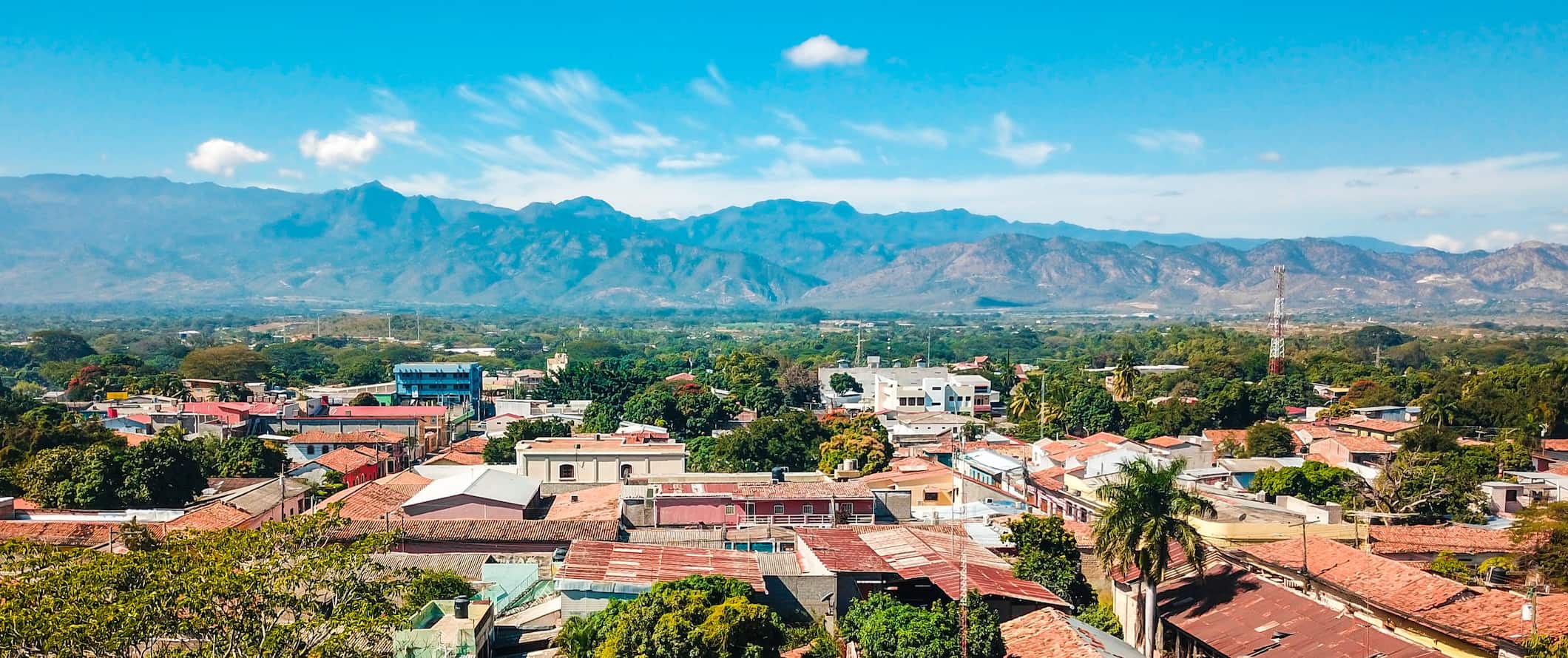
Bus – The cheapest way to get from A to B in Honduras is by bus. For local city journeys, taxis are recommended due to safety issues (petty theft is common on public transportation).
Direct buses for cross-country trips are more expensive but more comfortable and faster than the slower buses that make multiple stops. A direct bus from Tegucigalpa to La Ceiba takes around 6 hours and costs 860-950 HNL. A direct bus from Tegucigalpa to Copan Ruinas takes 9 hours and costs 1,293 HNL.
The multiple-stop buses ( parando ) are slower and can add a few extra hours to your trip. But, if you’re not in a rush, they can save you upwards of 50%.
Taxi – Taxis are plentiful and can be found pretty much everywhere. Fares start at 74 HNL and are charged at 65 HNL per kilometer.
Shared taxis ( colectivos ) are common for popular routes in the bigger cities too and will slash the private rates in half. Negotiate prices prior to getting in the car. Ask your hotel/hostel staff for rates before you arrive so you aren’t ripped off.
When on the islands, water taxis are your best option for getting around. They run from Roatan to West End, and from Coyolito to Isla del Tigre. Shared water taxis cost between 75-100 HNL depending on the route.
Flying – Domestic flights in Honduras are expensive. Connections between the major cities (La Ceiba, Tegucigalpa, San Pedro Sula) to Roatan, run frequently, however, one-way tickets to these key destinations usually cost between 3,000-4,250 HNL each way. If you’re on a budget, avoid flying.
Car rental – Driving in Honduras is not recommended as the roads aren’t that safe (landslides, flooding), there’s heavy traffic, and robberies are common. Avoid renting a car and stick to buses.
When to Go to Honduras
Honduras is, for the most part, a year-round destination. Temperatures hover around the 27-32°C (82-90°F) mark all year. However, the clammy humidity can feel like it’s higher than that during the rainy season (May-November).
Hurricanes are possible from April to October, however, if you’re willing to change your travel plans on a whim due to the weather, you can save a lot of money by visiting during this period. Be aware that booking during las lluvias (the rainy season), means rural areas (and hiking trails) can be harder to access due to storms.
The driest months, from December to April are considered peak season and are the best (albeit most expensive time) to visit. The coastal areas are particularly packed during this period, although ‘busy’ for Honduras is still pretty quiet compared to other popular Latin American destinations. If you’re serious about diving, you’re also going to get the best visibility during this time.
How to Stay Safe in Honduras
Honduras has found it difficult to shrug off its former status as the ‘murder capital of the world.’ Yet the country has improved leaps and bounds in terms of safety and the majority of travelers have no trouble navigating the country safely.
Homicides decreased by over 50% from 2012-2019 and kidnappings declined by 82% from 2013-2019. The majority of crimes happen in the major cities: Tegucigalpa, San Pedro Sula, and La Ceiba so I would be extra vigilant in those places, especially at night. (I wouldn’t walk around the capital at night alone.)
Outside of those areas, crime is much less common (especially in the Bay Islands). That being said, it’s important to keep an eye on your belongings on public transport, in busy urban areas, and near bus stops/stations.
Take cabs at night (ideally with other travelers) instead of walking alone and avoid walking down side streets that are not well lit.
Walking around during the daytime is usually trouble-free as long as you keep your valuables out of sight and don’t flash fancy jewelry, phones, or money.
Avoid taking the city bus, where pickpocketing is rife.
Since scams can occur here, read about common travel scams to avoid so you can be prepared.
Solo female travelers should generally feel safe here as long as they follow the advice above. Additionally, the standard precautions apply (never leave your drink unattended at the bar, never walk home alone intoxicated, etc.).
If you’re visiting during hurricane season (April-October), be sure to check the weather regularly.
If you experience an emergency, dial 911 for assistance.
The most important piece of advice I can offer is to purchase good travel insurance. Travel insurance will protect you against illness, injury, theft, and cancellations. It’s comprehensive protection in case anything goes wrong. I never go on a trip without it as I’ve had to use it many times in the past. You can use the widget below to find the policy right for you:
Honduras Travel Guide: The Best Booking Resources
These are my favorite companies to use when I travel. They consistently have the best deals, offer world-class customer service and great value, and overall, are better than their competitors. They are the companies I use the most and are always the starting point in my search for travel deals.
- Skyscanner – Skyscanner is my favorite flight search engine. They search small websites and budget airlines that larger search sites tend to miss. They are hands down the number one place to start.
- Hostelworld – This is the best hostel accommodation site out there with the largest inventory, best search interface, and widest availability.
- Booking.com – The best all around booking site that constantly provides the cheapest and lowest rates. They have the widest selection of budget accommodation. In all my tests, they’ve always had the cheapest rates out of all the booking websites.
- Get Your Guide – Get Your Guide is a huge online marketplace for tours and excursions. They have tons of tour options available in cities all around the world, including everything from cooking classes, walking tours, street art lessons, and more!
- SafetyWing – Safety Wing offers convenient and affordable plans tailored to digital nomads and long-term travelers. They have cheap monthly plans, great customer service, and an easy-to-use claims process that makes it perfect for those on the road.
- LifeStraw – My go-to company for reusable water bottles with built-in filters so you can ensure your drinking water is always clean and safe.
- Unbound Merino – They make lightweight, durable, easy-to-clean travel clothing.
- Top Travel Credit Cards – Points are the best way to cut down travel expenses. Here’s my favorite point earning credit cards so you can get free travel!
Honduras Travel Guide: Related Articles
Want more info? Check out all the articles I’ve written on Asia travel and continue planning your trip:

Do You Need Travel Insurance for Costa Rica?

The Best Tour Companies in Costa Rica
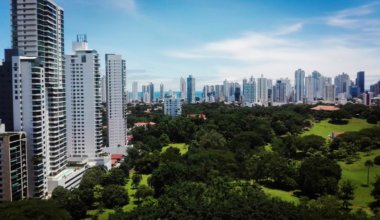
The 6 Best Hostels in Panama City, Panama
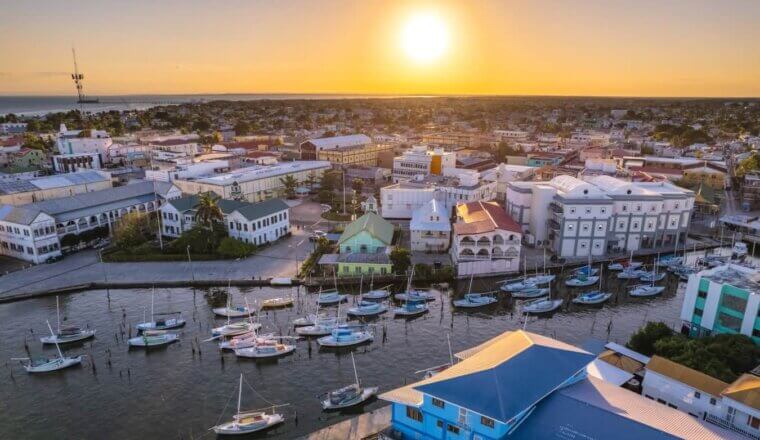
Is Belize Safe to Visit?

Is Central America Safe to Visit?
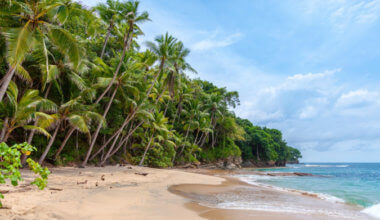
How to Get Around Central America on a Budget
Get your free travel starter kit.
Enter your email and get planning cheatsheets including a step by step checklist, packing list, tips cheat sheet, and more so you can plan like a pro!

- Where To Stay
- Transportation
- Booking Resources
- Related Blogs
Security Alert May 17, 2024
Worldwide caution, update may 10, 2024, information for u.s. citizens in the middle east.
- Travel Advisories |
- Contact Us |
- MyTravelGov |
Find U.S. Embassies & Consulates
Travel.state.gov, congressional liaison, special issuance agency, u.s. passports, international travel, intercountry adoption, international parental child abduction, records and authentications, popular links, travel advisories, mytravelgov, stay connected, legal resources, legal information, info for u.s. law enforcement, replace or certify documents.
Share this page:
Honduras Travel Advisory
Travel advisory july 17, 2023, honduras - level 3: reconsider travel.
Reissued with obsolete COVID-19 page links removed.
Reconsider travel to Honduras due to crime and kidnapping . Some areas have increased risk. Read the entire Travel Advisory.
Do not travel to:
- Gracias a Dios Department due to crime .
Country Summary : Violent crime, such as homicide, armed robbery, and kidnapping, is common. Violent gang activity, such as extortion, violent street crime, rape, and narcotics and human trafficking, is widespread. Local police and emergency services lack sufficient resources to respond effectively to serious crime.
Read the country information page for additional information on travel to Honduras.
If you decide to travel to Honduras:
- Avoid demonstrations.
- Be aware of your surroundings.
- Avoid walking or driving at night.
- Do not physically resist any robbery attempt.
- Be extra vigilant when visiting banks or ATMs.
- Do not display signs of wealth, such as wearing expensive watches or jewelry.
- Exercise caution using cell phones in public, including inside of cars while stopped in traffic.
- Visit our website for Travel to High-Risk Areas .
- Enroll in the Smart Traveler Enrollment Program (STEP) to receive Alerts and make it easier to locate you in an emergency.
- Follow the Department of State on Facebook and Twitter .
- Review the Country Security Report for Honduras.
- Prepare a contingency plan for emergency situations. Review the Traveler’s Checklist .
- Visit the CDC page for the latest Travel Health Information related to your travel.
Gracias a Dios Department – Level 4: Do Not Travel
Gracias a Dios is an isolated area with high levels of criminal activity and drug trafficking. Infrastructure is weak, government services are limited, and police and military presence is scarce.
- The U.S. government has limited ability to provide emergency services to U.S. citizens in Gracias a Dios as U.S. government employees are restricted from traveling to the area.
Visit our website for Travel to High-Risk Areas
Travel Advisory Levels
Assistance for u.s. citizens, honduras map, search for travel advisories, external link.
You are about to leave travel.state.gov for an external website that is not maintained by the U.S. Department of State.
Links to external websites are provided as a convenience and should not be construed as an endorsement by the U.S. Department of State of the views or products contained therein. If you wish to remain on travel.state.gov, click the "cancel" message.
You are about to visit:

Garifuna Tours
Since 1994 offering the best tours in Honduras
Since 1994 Garifuna Tours offers tours in all the main localities of Honduras organizing excursiones to the most attraction sites of the country …national parks, protected areas, archaeological and historic sites, visits to villages and islands where it is possible to know the live cultures present in the country.
Jeannette Kawas National Park (Punta Sal, Miami and Los Micos Lagoon), Punta Izopo National Park (Rio Platano and Triunfo de la Cruz), Lancetilla Botanical Garden, Rafting in Rio Cangrejal, Cayo Cochinos archipelago are some of the day tours available. Have an unforgettable adventure, choose your tours and book them with us!

TELA · JEANNETTE KAWAS NATIONAL PARK Boat Tour (8:00 am – 3:00 pm)
Virgin beach, snorkeling, hiking, flora, fauna and a delicious Garifuna style lunch. Offering the very best of both coastal marine and tropical forest ecosystems, An excursion of …

Los Micos Lagoon
TELA · JEANNETTE KAWAS NATIONAL PARK Car + Boat Tour (8:00 am – 3:00 pm)
Wildlife refuge lagoon that holds many canals with mangroves and small islands which serve as a refuge for an abundant marine life, reptiles and over …

Punta Izopo
TELA · PUNTA IZOPO NATIONAL PARK Car + Boat Tour (8:30 am – 3:00 pm)
Adrenaline, river of mangroves, lush jungle full of wildlife on a kayaking adventure. This amazing environment is home to many birds, reptiles, mammals and insects. …

Cayos Cochinos
LA CEIBA · CAYO COCHINOS Car + Boat Tour (6:00 am – 4:00 pm)
Coral reefs and pristine sandy beaches make up this archipelago of 13 cays, a time of snorkeling while taking in the incredible tranquility of this marine …

Lancetilla Botanical Garden
TELA · LANCETILLA Car + Hike Tour (4 hours trip)
Lancetilla is the second largest tropical botanical garden in the world. The diverse habitats that are found within the reserve are the secret to this paradise. Includes: transportation r/t, guide, …

Garifuna Villages
TELA · GARIFUNA COMMUNITIES Car Tour (4 hours trip)
Garifuna villages are one of Tela’s most beautiful attractions. Not only because of its amazing ecological beauty but because it holds the culture of the Garifunas. Includes: transportation r/t, guide, Triunfo …
Tela National Parks


There are a Total of Three Tela National Parks:
The westernmost destination within Atlantida offers three Tela National Parks or protected areas. This makes it a great destination for nature lovers who want to share their vacation time between the beaches and nature. Since Tela is halfways between San Pedro Sula and La Ceiba , you can even plan on visiting one of these areas if you are not actually spending the night in Tela. Travel time from both, San Pedro Sula and La Ceiba to Tela is under 1 ½ hours!
Most of the alternatives that the Tela National Parks offer are marine related. The exception is the Lancetilla Botanical Garden. This site will allow you to get close up the tropical rain forests of Central America. If you have interest in Nature and Honduras National Parks, Tela offers great alternatives for you to enjoy.
The three Tela National Parks are the following:
Jeannette Kawas National Park
Punta Izopo National Park
Lancetilla Botanical Gardens
If you enjoyed it please share it:
- Click to share on Facebook (Opens in new window)
- Click to share on Twitter (Opens in new window)
- Click to share on LinkedIn (Opens in new window)
- Click to share on Pinterest (Opens in new window)

Palmerola International Airport to be a Game Changer
Palmerola Intenational Airport with its 2.4 km long runway will also allow become an important cargo facility. Currently, Toncontin Airport has many limitations, due to its short runway, and difficult approach. This is expected to make of this central area of Honduras an important logistical hub. This will result in increased infrastructure and development of the area.

Bonacca Town
Bonacca town is the largest community on the island of Guanaja. It is where the seat of the municipal government is, and was, until early on the morning of October 2, one of the most unique towns in the Caribbean and in Central America. Some people consider that Bonacca Town is the Venice of the […]

Update to Honduras Immigration Requirements
As of June 10, Congress approved a modification to the law that required that all persons, Hondurans, and foreigners entering the country had to provide a negative COVID 19 test taken within 72 hours of their arrival into Honduras. The new law states that if you are fully vaccinated you can now enter the country without the negative test.

Where does the name of Honduras come from?
The answer is easy if you ask any Honduran citizen! Christopher Columbus, that great seafaring adventurer who discovered America randomly arrived at the Honduras coast in August 1502. His first stop was at the Island of Guanaja. His second was in what today is the Bay of Trujillo. After claiming the land for the Spanish […]

The Cangrejal River, one of the 30 Wonders of Honduras!
The magnificent Cangrejal River was declared one of the 30 Wonders of Honduras back in 2011. It was the eighth most voted wonder at the time. The River meanders between Pico Bonito and Nombre de Dios National Parks. It offers the ideal setting for adventure and nature tourism activities. Many lodges and operators offer services in the area.

2021 Golf Update in Honduras
There have been two different events that had a big impact in the Golf alternatives in Honduras last year. The first was the Covid-19 pandemic, that pushed the country into a lockdown. The second were the back-to-back tropical storms ETA & IOTA. These storms caused heavy flooding in the Sula Valley.

Honduras Bicentennial Celebration
Honduras celebrates 200 years as an independent country this year! I still remember when I had a chance to participate in the bicentennial celebration in 1976 in the USA. I am not a US citizen, but I was there for the US bicentennial as part of the tall ship parade up the Hudson River on July 4, 1976.
- Skip to main content
- Skip to "About this site"
Language selection
Search travel.gc.ca.
Help us to improve our website. Take our survey !
COVID-19: travel health notice for all travellers
Honduras travel advice
Latest updates: Editorial change
Last updated: June 7, 2024 11:35 ET
On this page
Safety and security, entry and exit requirements, laws and culture, natural disasters and climate, honduras - exercise a high degree of caution.
Exercise a high degree of caution in Honduras due to crime.
Regional advisory - Avoid non-essential travel
- within 20 km of the border with Guatemala, excluding:
- Copán Ruinas
- El Florido border crossing
- CA-11 Highway to El Florido border crossing
- within 20 km of the border with El Salvador, excluding :
- CA-1 Highway to the El Amatillo border crossing
- CA-4 Highway to the El Poy border crossing
- RN-112 Highway between Palmerola airport and the municipality of El Amatillo
- in the departments of:
- Choluteca: the city of Choluteca
- Colón, excluding the city of Trujillo
- Cortés:
- the eastern neighbourhoods of San Pedro Sula:
- Chamalecón
- Cofradía
- Rivera Hernandez
- the city of Choloma
- the neighbourhood of El Planeta in the city of La Lima
- Francisco Morazán: the city of Comayagüela, excluding the Toncontin airport and the major roads leading there
- Gracias a Dios
Back to top
Borders areas
Border areas often see higher criminal activity and violence.
If you’re travelling by land to neighbouring countries:
- use official border crossings only
- consider crossing borders in the morning as they sometimes close unexpectedly early
- avoid anyone suggesting that they can obtain your documents quicker or cheaper on your behalf
- keep the receipt of payment of the border fee until you leave the country
Criminal groups are especially active on the coast between the Guatemalan border and Puerto Cortés. Criminal activities include:
- drug trafficking
- human trafficking
There has also been an increased number of migrants leaving Honduras through Guatemala, particularly at the border crossing in Agua Caliente. This movement results in periodic closures.
The El Florido border crossing in the town of Copán is also closed daily from 9 pm to 6 am.
There has also been an increased number of migrants leaving Nicaragua through Honduras, particularly at the border crossings in Las Manos and Trojes.
Expect possible delays at borders.
Department of Cortés
Street gangs and criminal groups are very active in the Cortés municipalities of:
- San Pedro Sula
The number of murder and violent crime is higher in these areas.
Departments of Colón, Gracias a Dios, Olancho and Yoro
Drugs smuggling and violence pose security threats in the northern departments of:
- Colón
Roadblocks and violent incidents related to land disputes in Colón, mostly in the Aguán valley and in the north coast area near Trujillo, have occurred.
The department of Gracias a Dios is a remote area where law enforcement and access to government services are very limited. Levels of criminal activity are high.
Violent crime is high in the coastal city of La Ceiba. This includes murders and armed robberies.
Although tourists are not the primary target of criminals, you could be in the wrong place at the wrong time.
If you consider travelling to La Ceiba:
- use reputable tour operators only
- choose accommodation with good security measures
- avoid outings outside the resort
Bay Islands
The Bay Islands are generally safe. Violent crime is lower, but petty crime sometimes occurs.
Some foreigners have been assaulted on beaches, mainly at night. Home burglaries have also occurred, sometimes in rental accommodations.
While in the Bay Islands:
- avoid Coxen hole, Los Fuertes and Suampo neighbourhoods after dark
- avoid isolated beaches and areas
- stay in well-lit areas
- make sure you lock windows and doors at night and when you are away
If you’re docking in Roatán and getting off the cruise ship, you should consider booking a tour or a sightseeing trip through a reputable company to avoid becoming the victim of a scam.
Violent crime
Although the overall situation has slightly improved since 2022, violent crime remains a concern throughout Honduras. The country retains one of the highest homicide rates in the world.
Drug trafficking, transnational organized crime and street gang activity is prevalent in certain neighbourhoods. Violent incidents are frequent, including:
- armed robberies
- kidnappings
- home invasions
- sexual assaults
These crimes are carried out by criminals acting individually or as a group.
Many Hondurans are armed. Guns and other weapons, such as machetes and knives, are frequently used. Incidents of armed robbery occur mainly on urban streets during the day and on intercity buses at night.
The Government of Honduras lacks sufficient resources to properly respond to, investigate and prosecute cases. Infiltration within the security forces by local gangs weaken law enforcement even further. Criminals linked to organized crime often operate with a high degree of impunity throughout Honduras.
- Remain aware of your surroundings at all times
- Maintain your cellphone charged
- Avoid travelling after dark
- Avoid walking alone
- Keep a low profile
- Avoid carrying large amounts of cash
- don’t resist if you’re threatened, hand over your cash and valuables immediately
Petty crime
Petty crime, such as pickpocketing and bag snatching, occurs. Thefts commonly occur in:
- popular tourist areas
- bus terminals and airports
- shopping malls and hotel lobbies
- restaurants, including patios
To avoid becoming a victim:
- be suspicious of recent acquaintances or strangers approaching you
- avoid accepting rides or invitations from strangers
- avoid hitchhiking
- ensure that your belongings, including your passport and other travel documents, are secured at all times
- avoid carrying large amounts of cash
- avoid showing signs of affluence
State of emergency
Local authorities periodically declare a state of emergency in various municipalities to fight against gang-related crime and extortion.
While a state of emergency is in effect, security forces have increased rights to conduct searches, seizures and detain persons of interest.
If you are travelling in an area where a state of emergency is in effect:
- be aware that you may be subject to searches by security forces
- always cooperate with military and police officers
- carry valid ID at all times and be prepared for various checkpoints
- allow extra time to reach your destination
- follow the instructions of local authorities
- monitor local news to stay informed on the current situation
Express kidnappings
Express kidnappings can occur in urban areas.
These kidnappings are often committed by organised gangs or taxi drivers. The kidnappers usually take their victims to an ATM and force them to make a cash withdrawal.
- Avoid hailing taxis on the street
- If you’re threatened, don’t resist
Demonstrations and civil unrest
Demonstrations take place regularly. In Tegucigalpa, demonstrations may occur:
- at the National Congress and Central Park
- at the National Autonomous University of Honduras
- at the United States Embassy
- at the Centro Civico
- at the Presidential Palace
- at the Hospital Escuela
- on Suyapa and Centroamerica boulevards
- on La Paz and Los Próceres avenues
- along the Peripheral Ring Road
In San Pedro Sula, protesters usually gather at the Monumento a la Madre.
Even peaceful demonstrations can turn violent at any time. They can lead to disruptions to traffic and public transportation.
- Avoid areas where demonstrations and large gatherings are taking place
- Follow the instructions of local authorities
- Monitor local media for information on ongoing demonstrations
Honduran law prohibits political activities by foreigners. Participating in demonstrations or activities may result in you being detained or deported.
Mass gatherings (large-scale events)
Credit card and ATM fraud occurs.
Be cautious when using debit or credit cards:
- cover the keypad with one hand when entering your PIN
- pay careful attention when your cards are being handled by others
- avoid using card readers with an irregular or unusual feature
- use ATMs located in well-lit public areas or inside a bank or business
- check for any unauthorized transactions on your account statements
Overseas fraud
Spiked food and drinks
Snacks, beverages, gum and cigarettes may contain drugs that could put you at risk of sexual assault and robbery.
- Be wary of accepting these items from new acquaintances
- Never leave food or drinks unattended or in the care of strangers
Women’s safety
Women travelling alone may be subject to some forms of harassment and verbal abuse.
Advice for women travellers
Water activities
Coastal waters can be dangerous. Riptides are common.
Rescue services may not be consistent with international standards. Not all beaches have lifeguards or warning flags to warn of unsafe conditions.
- Only undertake scuba diving and other water activities with a well-established company
- Don’t swim alone alone or outside marked areas
- Consult residents and tour operators for information on possible hazards and safe swimming areas
- Monitor weather warnings
Water safety abroad
Adventure tourism
Outdoor activities, such as hiking, diving, mountain biking and other adventure activities can be dangerous if unprepared. Trails are not always marked, and weather conditions can change rapidly, even in during summer.
If you intend to practice adventure tourism:
- never do so alone, and do not part with your expedition companions
- obtain detailed information on your activity and on the environment in which you will be before setting out
- buy travel insurance that includes helicopter rescue and medical evacuation
- ensure that your physical condition is good enough to meet the challenges of your activity
- avoid venturing off marked trails
- ensure that you’re adequately equipped and bring sufficient water
- stay informed about weather and other conditions that may pose a hazard
- refrain from using facilities or equipment if you have doubts on their safety
- inform a family member or friend of your itinerary
Road travel
Road conditions and road safety are poor throughout the country. Accidents causing fatalities are common. The number of traffic accidents involving tourists has also increased.
Road conditions
Many roads are poorly delineated due to regular flooding. Driving can be dangerous due to:
- roaming livestock and wildlife
- poorly maintained roads and bridges
- unpaved roads
- inadequate lighting
- lack of signage
- lack of guardrails
- winding mountain roads
- overloaded or poorly maintained vehicles
- slow-moving or heavy traffic, especially in San Pedro Sula and Tegucigalpa
If you’re travelling by land, use caution between:
- El Progreso and La Ceiba
- Chamelecón and Copán via Cofradía
- Copán and Gracias Lempira
- Limones to La Unión
Between Tegucigalpa to Trujillo, you should use the RN39 and transit via Gualaco, San Esteban and Bonito Oriental rather than the RN41 via Salamá et Sabá.
Road safety
Drivers don’t respect traffic laws. They often drive at excessive speeds. They may be aggressive and reckless.
If you drive in Honduras:
- always drive defensively
- maintain a heightened awareness along all routes
- plan your trip ahead of time, especially if you plan to visit a rural area
- avoid road travel at night
- keep your car doors locked and the windows closed at all times
- avoid picking up hitchhikers
- carry a cell phone and a charger
- avoid renting cars and motorcycles from operators who don’t provide insurance
- ensure that helmets meet international safety standards
Police officer impersonation
Gang members and criminals sometimes disguise themselves as police officers. At legitimate police checkpoints, you should see:
- a police vehicle
- green cones
- at least five police officers
If you have any doubts, you may contact the Honduran Transit Authority by dialing 911 to confirm the location of the roadblocks and the identity of the individuals stopping you before rolling down your window or opening your door.
Sometimes, thieves also pose as victims of road accidents.
- Don’t stop to help a person at the side of the road
- Report any suspicious incidents at the next police checkpoint
Public transportation
Public transportation in Honduras is unsafe and unreliable.
Most urban public buses are poorly maintained. Drivers are reckless. Accidents are common.
Incidents of armed robbery are frequent on public buses. Incidents of arson have also occurred.
- Avoid intercity public transportation
- Use only companies that offer non-stop service from your place of departure to your destination
Some taxis are an acceptable option for transportation.
When travelling to the airport, you may pre-arrange your pickup with your hotel prior to your departure. Authorized airport taxis drivers wear easily identifiable ID badges.
- Use a reliable taxi company recommended by your hotel
- Don’t use white street taxis
- Never board taxis at taxi stands or flag taxis in the street
- Never use shared taxis
- Make sure the driver doesn’t pick up other passengers along the way to your destination
- Note driver’s name and plate number
- Negotiate the fare in advance
- Make sure you have small bills as taxi drivers often don’t make change
We do not make assessments on the compliance of foreign domestic airlines with international safety standards.
Information about foreign domestic airlines
Every country or territory decides who can enter or exit through its borders. The Government of Canada cannot intervene on your behalf if you do not meet your destination’s entry or exit requirements.
We have obtained the information on this page from the Honduran authorities. It can, however, change at any time.
Verify this information with the Foreign Representatives in Canada .
Entry requirements vary depending on the type of passport you use for travel.
Before you travel, check with your transportation company about passport requirements. Its rules on passport validity may be more stringent than the country’s entry rules.
Regular Canadian passport
Your passport must be valid at least 6 months from the date of entry.
Passport for official travel
Different entry rules may apply.
Official travel
Passport with “X” gender identifier
While the Government of Canada issues passports with an “X” gender identifier, it cannot guarantee your entry or transit through other countries. You might face entry restrictions in countries that do not recognize the “X” gender identifier. Before you leave, check with the closest foreign representative for your destination.
Other travel documents
Different entry rules may apply when travelling with a temporary passport or an emergency travel document. Before you leave, check with the closest foreign representative for your destination.
Useful links
- Foreign Representatives in Canada
- Canadian passports
Tourist visa: not required for stays up to 90 days Business visa: not required for stays up to 90 days Student permit: required
Student permit
If you intend to study in Honduras, you must obtain a student permit which can be obtained from the immigration authorities once you arrive in the country.
National Institute of Migration – Government of Honduras
Customs declaration form
You must complete the Government of Honduras' customs declaration form prior to entering or leaving the country.
After completing the online form, you must present the QR code to the customs authorities, either on paper or electronically.
Customs declaration form – Government of Honduras
Entry stamp
Immigration authorities will stamp your passport upon arrival and write down the number of days you are allowed in the country. The 90-day period is not guaranteed, and the decision is at their discretion.
You may face a fine and possible delays if you fail to present an entry-stamped passport when departing Honduras.
- Make sure your passport has been stamped upon arrival
- Take good note of the maximum length of your approved stay
Central America-4 Border Control Agreement
Under the terms of the Central America-4 Border Control Agreement (CA-4), Canadian tourists may travel freely within any of the following CA-4 countries:
- El Salvador
You can travel between these countries for up to 90 days without having to undergo entry and exit formalities at border immigration checkpoints.
You must still check in at immigration counters when you enter or exit these checkpoints.
The 90-day period begins at the first point of entry to any of the CA-4 countries. You will be fined if you exceed the 90-day limit.
Entering by land
If you plan to enter by land, you need to pay 3 USD or the equivalent in lempiras.
Stay extension
You can apply for extensions of up to 30 days at a time, at the discretion of the immigration authorities. You must request this extension and pay the required fee at the Honduran immigration office before your first 90-day limit expires.
Other entry requirements
Customs officials may ask you to show them:
- a return or onward ticket
- proof that you have sufficient funds for the duration of your stay
- Children and travel
The age of majority in Honduras is 21. The country has strict requirements for the entry and exit of minors.
A minor must show a written and notarized authorization to travel:
- signed by both parents if travelling alone
- signed by the non-travelling parent if travelling with one parent only
The written authorization must be in Spanish and authenticated by the Honduran authorities prior to arrival.
This is also enforced if the minor has a residential or citizenship tie to Honduras inherited from one of the parents, even if the tie has not been legally registered.
Travelling with children
Yellow fever
Learn about potential entry requirements related to yellow fever (vaccines section).
Relevant Travel Health Notices
- Global Measles Notice - 13 March, 2024
- Zika virus: Advice for travellers - 31 August, 2023
- COVID-19 and International Travel - 13 March, 2024
- Dengue: Advice for travellers - 6 May, 2024
This section contains information on possible health risks and restrictions regularly found or ongoing in the destination. Follow this advice to lower your risk of becoming ill while travelling. Not all risks are listed below.
Consult a health care professional or visit a travel health clinic preferably 6 weeks before you travel to get personalized health advice and recommendations.
Routine vaccines
Be sure that your routine vaccinations , as per your province or territory , are up-to-date before travelling, regardless of your destination.
Some of these vaccinations include measles-mumps-rubella (MMR), diphtheria, tetanus, pertussis, polio, varicella (chickenpox), influenza and others.
Pre-travel vaccines and medications
You may be at risk for preventable diseases while travelling in this destination. Talk to a travel health professional about which medications or vaccines may be right for you, based on your destination and itinerary.
There is a risk of hepatitis A in this destination. It is a disease of the liver. People can get hepatitis A if they ingest contaminated food or water, eat foods prepared by an infectious person, or if they have close physical contact (such as oral-anal sex) with an infectious person, although casual contact among people does not spread the virus.
Practise safe food and water precautions and wash your hands often. Vaccination is recommended for all travellers to areas where hepatitis A is present.
Measles is a highly contagious viral disease. It can spread quickly from person to person by direct contact and through droplets in the air.
Anyone who is not protected against measles is at risk of being infected with it when travelling internationally.
Regardless of where you are going, talk to a health care professional before travelling to make sure you are fully protected against measles.
Hepatitis B is a risk in every destination. It is a viral liver disease that is easily transmitted from one person to another through exposure to blood and body fluids containing the hepatitis B virus. Travellers who may be exposed to blood or other bodily fluids (e.g., through sexual contact, medical treatment, sharing needles, tattooing, acupuncture or occupational exposure) are at higher risk of getting hepatitis B.
Hepatitis B vaccination is recommended for all travellers. Prevent hepatitis B infection by practicing safe sex, only using new and sterile drug equipment, and only getting tattoos and piercings in settings that follow public health regulations and standards.
The best way to protect yourself from seasonal influenza (flu) is to get vaccinated every year. Get the flu shot at least 2 weeks before travelling.
The flu occurs worldwide.
- In the Northern Hemisphere, the flu season usually runs from November to April.
- In the Southern Hemisphere, the flu season usually runs between April and October.
- In the tropics, there is flu activity year round.
The flu vaccine available in one hemisphere may only offer partial protection against the flu in the other hemisphere.
The flu virus spreads from person to person when they cough or sneeze or by touching objects and surfaces that have been contaminated with the virus. Clean your hands often and wear a mask if you have a fever or respiratory symptoms.
Coronavirus disease (COVID-19) is an infectious viral disease. It can spread from person to person by direct contact and through droplets in the air.
It is recommended that all eligible travellers complete a COVID-19 vaccine series along with any additional recommended doses in Canada before travelling. Evidence shows that vaccines are very effective at preventing severe illness, hospitalization and death from COVID-19. While vaccination provides better protection against serious illness, you may still be at risk of infection from the virus that causes COVID-19. Anyone who has not completed a vaccine series is at increased risk of being infected with the virus that causes COVID-19 and is at greater risk for severe disease when travelling internationally.
Before travelling, verify your destination’s COVID-19 vaccination entry/exit requirements. Regardless of where you are going, talk to a health care professional before travelling to make sure you are adequately protected against COVID-19.
Malaria is a serious and sometimes fatal disease that is caused by parasites spread through the bites of mosquitoes. There is a risk of malaria in certain areas and/or during a certain time of year in this destination.
Antimalarial medication may be recommended depending on your itinerary and the time of year you are travelling. Consult a health care professional or visit a travel health clinic before travelling to discuss your options. It is recommended to do this 6 weeks before travel, however, it is still a good idea any time before leaving. Protect yourself from mosquito bites at all times: • Cover your skin and use an approved insect repellent on uncovered skin. • Exclude mosquitoes from your living area with screening and/or closed, well-sealed doors and windows. • Use insecticide-treated bed nets if mosquitoes cannot be excluded from your living area. • Wear permethrin-treated clothing. If you develop symptoms similar to malaria when you are travelling or up to a year after you return home, see a health care professional immediately. Tell them where you have been travelling or living.
Yellow fever is a disease caused by a flavivirus from the bite of an infected mosquito.
Travellers get vaccinated either because it is required to enter a country or because it is recommended for their protection.
- There is no risk of yellow fever in this country.
Country Entry Requirement*
- Proof of vaccination is required if you are coming from or have transited through an airport of a country where yellow fever occurs.
Recommendation
- Vaccination is not recommended.
- Discuss travel plans, activities, and destinations with a health care professional.
- Contact a designated Yellow Fever Vaccination Centre well in advance of your trip to arrange for vaccination.
About Yellow Fever
Yellow Fever Vaccination Centres in Canada * It is important to note that country entry requirements may not reflect your risk of yellow fever at your destination. It is recommended that you contact the nearest diplomatic or consular office of the destination(s) you will be visiting to verify any additional entry requirements.
In this destination, rabies is commonly carried by dogs and some wildlife, including bats. Rabies is a deadly disease that spreads to humans primarily through bites or scratches from an infected animal. While travelling, take precautions , including keeping your distance from animals (including free-roaming dogs), and closely supervising children.
If you are bitten or scratched by a dog or other animal while travelling, immediately wash the wound with soap and clean water and see a health care professional. In this destination, rabies treatment may be limited or may not be available, therefore you may need to return to Canada for treatment.
Before travel, discuss rabies vaccination with a health care professional. It may be recommended for travellers who are at high risk of exposure (e.g., occupational risk such as veterinarians and wildlife workers, children, adventure travellers and spelunkers, and others in close contact with animals).
Safe food and water precautions
Many illnesses can be caused by eating food or drinking beverages contaminated by bacteria, parasites, toxins, or viruses, or by swimming or bathing in contaminated water.
- Learn more about food and water precautions to take to avoid getting sick by visiting our eat and drink safely abroad page. Remember: Boil it, cook it, peel it, or leave it!
- Avoid getting water into your eyes, mouth or nose when swimming or participating in activities in freshwater (streams, canals, lakes), particularly after flooding or heavy rain. Water may look clean but could still be polluted or contaminated.
- Avoid inhaling or swallowing water while bathing, showering, or swimming in pools or hot tubs.
Travellers' diarrhea is the most common illness affecting travellers. It is spread from eating or drinking contaminated food or water.
Risk of developing travellers' diarrhea increases when travelling in regions with poor standards of hygiene and sanitation. Practise safe food and water precautions.
The most important treatment for travellers' diarrhea is rehydration (drinking lots of fluids). Carry oral rehydration salts when travelling.
Typhoid is a bacterial infection spread by contaminated food or water. Risk is higher among children, travellers going to rural areas, travellers visiting friends and relatives or those travelling for a long period of time.
Travellers visiting regions with a risk of typhoid, especially those exposed to places with poor sanitation, should speak to a health care professional about vaccination.
Insect bite prevention
Many diseases are spread by the bites of infected insects such as mosquitoes, ticks, fleas or flies. When travelling to areas where infected insects may be present:
- Use insect repellent (bug spray) on exposed skin
- Cover up with light-coloured, loose clothes made of tightly woven materials such as nylon or polyester
- Minimize exposure to insects
- Use mosquito netting when sleeping outdoors or in buildings that are not fully enclosed
To learn more about how you can reduce your risk of infection and disease caused by bites, both at home and abroad, visit our insect bite prevention page.
Find out what types of insects are present where you’re travelling, when they’re most active, and the symptoms of the diseases they spread.
There is a risk of chikungunya in this country. The risk may vary between regions of a country. Chikungunya is a virus spread through the bite of an infected mosquito. Chikungunya can cause a viral disease that typically causes fever and pain in the joints. In some cases, the joint pain can be severe and last for months or years.
Protect yourself from mosquito bites at all times. There is no vaccine available for chikungunya.
- In this country, dengue is a risk to travellers. It is a viral disease spread to humans by mosquito bites.
- Dengue can cause flu-like symptoms. In some cases, it can lead to severe dengue, which can be fatal.
- The level of risk of dengue changes seasonally, and varies from year to year. The level of risk also varies between regions in a country and can depend on the elevation in the region.
- Mosquitoes carrying dengue typically bite during the daytime, particularly around sunrise and sunset.
- Protect yourself from mosquito bites . There is no vaccine or medication that protects against dengue.
Zika virus is a risk in this country.
Zika virus is primarily spread through the bite of an infected mosquito. It can also be sexually transmitted. Zika virus can cause serious birth defects.
During your trip:
- Prevent mosquito bites at all times.
- Use condoms correctly or avoid sexual contact, particularly if you are pregnant.
If you are pregnant or planning a pregnancy, you should discuss the potential risks of travelling to this destination with your health care provider. You may choose to avoid or postpone travel.
For more information, see Zika virus: Pregnant or planning a pregnancy.
American trypanosomiasis (Chagas disease) is a risk in this country. It is caused by a parasite spread by infected triatomine bugs. The infection can be inactive for decades, but humans can eventually develop complications causing disability and even death.
Risk is generally low for most travellers. Protect yourself from triatomine bugs, which are active at night, by using mosquito nets if staying in poorly-constructed housing. There is no vaccine available for Chagas disease.
Animal precautions
Some infections, such as rabies and influenza, can be shared between humans and animals. Certain types of activities may increase your chance of contact with animals, such as travelling in rural or forested areas, camping, hiking, and visiting wet markets (places where live animals are slaughtered and sold) or caves.
Travellers are cautioned to avoid contact with animals, including dogs, livestock (pigs, cows), monkeys, snakes, rodents, birds, and bats, and to avoid eating undercooked wild game.
Closely supervise children, as they are more likely to come in contact with animals.
Person-to-person infections
Stay home if you’re sick and practise proper cough and sneeze etiquette , which includes coughing or sneezing into a tissue or the bend of your arm, not your hand. Reduce your risk of colds, the flu and other illnesses by:
- washing your hands often
- avoiding or limiting the amount of time spent in closed spaces, crowded places, or at large-scale events (concerts, sporting events, rallies)
- avoiding close physical contact with people who may be showing symptoms of illness
Sexually transmitted infections (STIs) , HIV , and mpox are spread through blood and bodily fluids; use condoms, practise safe sex, and limit your number of sexual partners. Check with your local public health authority pre-travel to determine your eligibility for mpox vaccine.
Tuberculosis is an infection caused by bacteria and usually affects the lungs.
For most travellers the risk of tuberculosis is low.
Travellers who may be at high risk while travelling in regions with risk of tuberculosis should discuss pre- and post-travel options with a health care professional.
High-risk travellers include those visiting or working in prisons, refugee camps, homeless shelters, or hospitals, or travellers visiting friends and relatives.
HIV (Human Immunodeficiency Virus) is a virus that attacks and impairs the immune system, resulting in a chronic, progressive illness known as AIDS (Acquired Immunodeficiency Syndrome).
High risk activities include anything which puts you in contact with blood or body fluids, such as unprotected sex and exposure to unsterilized needles for medications or other substances (for example, steroids and drugs), tattooing, body-piercing or acupuncture.
Medical services and facilities
Good health care is limited in availability. The quality of care varies greatly throughout the country.
Public medical services and facilities remain below Canadian standards. Medical facilities are understaffed and underfunded. They lack medical supplies and adequately trained professionals.
You should use private health care where possible. There are some private clinics and hospitals in San Pedro Sula and Tegucigalpa as well as in tourist areas such as the Bay Islands. However, they are often limited and services are expensive.
Doctors typically require upfront payment in cash. They may only speak Spanish.
Emergency services may not be able to access areas outside of major cities. Emergency medical facilities are also very limited on the Bay Islands. Major medical procedures and surgeries may require medical evacuation to a major centre.
Make sure you get travel insurance that includes coverage for medical evacuation and hospital stays.
Travel health and safety
Some prescription medication may not be available in Honduras.
If you take prescription medication, you’re responsible for determining their legality in the country.
- Bring sufficient quantities of your medication with you
- Always keep your medication in the original container
- Pack your medication in your carry-on luggage
- Carry a copy of your prescriptions
Air pollution
Air pollution can be severe in major cities, especially at its peak during the dry season between March and May. It may primarily affect the elderly, pregnant women and children, and people suffering from respiratory ailments.
During periods of high pollution:
- wear a mask and use air purifiers
- limit your activities outdoors
- monitor local media
Keep in Mind...
The decision to travel is the sole responsibility of the traveller. The traveller is also responsible for his or her own personal safety.
Be prepared. Do not expect medical services to be the same as in Canada. Pack a travel health kit , especially if you will be travelling away from major city centres.
You must abide by local laws.
Learn about what you should do and how we can help if you are arrested or detained abroad .
Transfer to a Canadian prison
Canada and Honduras are signatories to the Convention on the Transfer of Sentenced Persons. This enables a Canadian imprisoned in Honduras to request a transfer to a Canadian prison to complete a sentence. The transfer requires the agreement of both Canadian and Honduran authorities.
This process can take a long time, and there is no guarantee that the transfer will be approved by either or both sides.
Penalties for possession, use or trafficking of illegal drugs are severe. Convicted offenders can expect lengthy jail sentences or heavy fines.
Honduras is used as a drug trafficking hub between South and North America.
- Pack your own luggage and monitor it closely at all times
- Don’t transport other people’s packages, bags or suitcases
- Never exchange money for strangers, as this is a common request from money launderers
Drugs, alcohol and travel
Honduran law prohibits the export of:
- antiques and artifacts from pre-colonial civilizations
- some birds, feathers, flora and fauna
Investments
Disputes related to property acquisition or other investments are costly and take time to resolve.
Many tourists have reported complications during real estate transactions in Honduras.
If you plan on buying property, or making other investments in Honduras:
- seek legal advice in Canada and in Honduras before making commitments
- choose your own Honduran lawyer specializing in real estate
- avoid hiring a lawyer recommended by a seller
- visit the property in person before purchasing
- carefully review the sales contract as it may contain irregularities
- confirm the name of the last owner and verify that the property is free of any mortgage or taxes from the local property registry (Instituto de la propiedad)
- confirm that there are no heritage or land ownership disputes
Political activities
It’s illegal for foreigners to participate in local political activities, rallies or public demonstrations in Honduras.
Political involvement may result in your deportation or expulsion.
Dual citizenship
Dual citizenship is legally recognized in Honduras.
If you are a Canadian citizen, but also a citizen of Honduras, our ability to offer you consular services may be limited while you're there. You may also be subject to different entry/exit requirements .
Travellers with dual citizenship
2SLGBTQI+ travellers
Honduran law does not prohibit sexual acts between individuals of the same sex. However, same-sex couples are not legally recognized.
LGBTQ2 travellers could be discriminated against based on their sexual orientation, gender identity, gender expression, or sex characteristics.
Avoid public displays of affection.
Travel and your sexual orientation, gender identity, gender expression and sex characteristics
International Child Abduction
The Hague Convention on the Civil Aspects of International Child Abduction is an international treaty. It can help parents with the return of children who have been removed to or retained in certain countries in violation of custody rights. The convention applies between Canada and Honduras.
If your child was wrongfully taken to, or is being held in Honduras, and if the applicable conditions are met, you may apply for the return of your child to the Honduran court.
If you are in this situation:
- act as quickly as you can
- contact the Central Authority for your province or territory of residence for information on starting an application under The Hague Convention
- consult a lawyer in Canada and in Honduras to explore all the legal options for the return of your child
- report the situation to the nearest Canadian government office abroad or to the Vulnerable Children's Consular Unit at Global Affairs Canada by calling the Emergency Watch and Response Centre
If your child was removed from a country other than Canada, consult a lawyer to determine if The Hague Convention applies.
Be aware that Canadian consular officials cannot interfere in private legal matters or in another country's judicial affairs.
- List of Canadian Central Authorities for the Hague Convention
- International Child Abductions: A guide for affected parents
- The Hague Convention – Hague Conference on Private International Law
- Canadian embassies and consulates by destination
- Request emergency assistance
You may drive in Honduras with your valid Canadian driver license for up to 3 months.
At all times when driving, you must carry:
- your driver’s license
- your passport
- the vehicle’s registration
In the event of a car accident:
- remain at the scene
- don’t move your vehicle until the authorities arrive
- call 911 to report the accident and request Transit Police
Failure to remain at the site may be considered an admission of guilt under Honduran law. However, some accidents may attract a crowd that could turn hostile. If you feel unsafe:
- ensure your windows and doors are locked
- drive to the nearest police station or a secure location
- report the accident to the police and your insurance company as soon as possible
If you are involved in a road accident causing injuries, you may be temporarily detained, regardless of culpability.
International Driving Permit
The currency in Honduras is the lempira (HNL).
You cannot exchange Canadian dollars in Honduras. You can easily exchange U.S. dollars.
ATMs are available in urban areas but not all foreign cards work at all ATMs or points of service. They may be rare in rural areas.
A valid passport is required for all financial transactions.
Hurricane season
Hurricanes usually occur from mid-May to the end of November. During this period, even small tropical storms can quickly develop into major hurricanes.
These severe storms can put you at risk and hamper the provision of essential services. You could face serious safety risks during a hurricane.
If you decide to travel to a coastal area during the hurricane season:
- be prepared to change your travel plans on short notice, including cutting short or cancelling your trip
- stay informed of the latest regional weather forecasts
- carry emergency contact information for your airline or tour operator
- follow the advice and instructions of local authorities
- Tornadoes, cyclones, hurricanes, typhoons and monsoons
- Large-scale emergencies abroad
- Active storm tracking and hurricane watches and warnings – U.S. National Hurricane Center
Rainy season
The rainy season extends from May to November. It can lead to severe flooding.
Seasonal flooding can hamper overland travel and reduce the provision of essential services. Roads may become impassable due to mudslides and landslides. Bridges, buildings, and infrastructure may be damaged.
- Monitor local media for the latest updates, including those on road conditions
- Stay away from flooded areas
- Monitor weather reports
- Follow the instructions of local authorities, including evacuation orders
Wildfires are common between December and April.
The air quality in areas near active fires may deteriorate due to heavy smoke.
In case of a major fire:
- stay away from the affected area, particularly if you suffer from respiratory ailments
- follow the instructions of local emergency services personnel
- monitor local media for up-to-date information on the situation
Earthquakes and tsunamis
Honduras is located in an active seismic zone. Earthquakes and tsunamis can occur.
Even minor earthquakes can cause significant damage.
Tsunami warnings may be issued after a strong earthquake. A tsunami can occur within minutes of a nearby earthquake. However, the risk of tsunami can remain for several hours following the first tremor. If you’re staying on the coast, familiarize yourself with the region’s evacuation plans in the event of a tsunami warning.
- COPECO - Honduran disaster relief agency (in Spanish)
- Earthquakes - What to Do?
- Latest earthquakes - U.S. Geological Survey
- Tsunami alerts - U.S. Tsunami Warning System
Local services
In case of emergency, dial 911.
There are tourist police forces in the following cities:
- Cantarranas
- San Lorenzo
- Santa Lucía
- Tegucigalpa
- Valle de Ángeles
Consular assistance
Costa Rica, Honduras, Nicaragua
For emergency consular assistance, call the office of the Embassy of Canada to Honduras, in Tegucigalpa, and follow the instructions. At any time, you may also contact the Emergency Watch and Response Centre in Ottawa.
The decision to travel is your choice and you are responsible for your personal safety abroad. We take the safety and security of Canadians abroad very seriously and provide credible and timely information in our Travel Advice to enable you to make well-informed decisions regarding your travel abroad.
The content on this page is provided for information only. While we make every effort to give you correct information, it is provided on an "as is" basis without warranty of any kind, expressed or implied. The Government of Canada does not assume responsibility and will not be liable for any damages in connection to the information provided.
If you need consular assistance while abroad, we will make every effort to help you. However, there may be constraints that will limit the ability of the Government of Canada to provide services.
Learn more about consular services .
Risk Levels
take normal security precautions.
Take similar precautions to those you would take in Canada.
Exercise a high degree of caution
There are certain safety and security concerns or the situation could change quickly. Be very cautious at all times, monitor local media and follow the instructions of local authorities.
IMPORTANT: The two levels below are official Government of Canada Travel Advisories and are issued when the safety and security of Canadians travelling or living in the country or region may be at risk.
Avoid non-essential travel
Your safety and security could be at risk. You should think about your need to travel to this country, territory or region based on family or business requirements, knowledge of or familiarity with the region, and other factors. If you are already there, think about whether you really need to be there. If you do not need to be there, you should think about leaving.
Avoid all travel
You should not travel to this country, territory or region. Your personal safety and security are at great risk. If you are already there, you should think about leaving if it is safe to do so.
Indura Beach & Golf Resort Curio Collection by Hilton

Arrival time
A tropical stay on the Caribbean coast
Our Honduran villas are surrounded by tropical jungle and overlook the Caribbean Sea. Tela, Lancetilla Botanical Garden, and Punta Sal are within 14 kilometers. The resort features a spa, fitness center, tennis court, three swimming pools, and an 18-hole golf course. Enjoy dining at our restaurants, live music at Bahari Bar Lounge, and room service.
Our amenities
Free parking
Non-smoking rooms
On-site restaurant
Outdoor pool
Fitness center
Room service
Meeting rooms
Pets not allowed
Rooms and suites
Hilton Honors member benefits
Hilton Honors Discount rate
Points toward free nights and more
Choose Your Room
Digital Check-In
Hilton Honors Experiences
Digital Key
Hotel policies
Not available
Dining and drinks
Bazul blends international favorites with Honduran flavors, using locally-sourced ingredients. Enjoy cocktails and hearty lunches from Duna Beach Lounge. Bahari Bar Lounge serves coffee, drinks, and tapas.
Our unique golf course is surrounded by native mangroves and spectacular views of the Caribbean Sea. Set on 1,800 pristine tropical acres, the course is home to lagoons and wildlife habitats, and selecting the most sustainable turfgrass was key to the design.
Group travel and events
Location and transportation.
Airport shuttle

COMMENTS
Tela is halfway between San Pedro Sula and La Ceiba. This makes it easy to get to if you are traveling to Tela from an international hub. The San Pedro Sula International Airport is the busiest airport in Honduras. It is the only one that is open 24 hours a day in Honduras. Airlines, such as Aeromexico, American Airlines, Copa Airlines, Delta ...
Tela Tourism: Tripadvisor has 3,480 reviews of Tela Hotels, Attractions, and Restaurants making it your best Tela resource. ... Tourism Tela Hotels Tela Bed and Breakfast Tela Vacation Rentals Flights to Tela Tela Restaurants Things to Do in Tela Tela Travel Forum Tela Photos Tela Map. ... Tela, Honduras. Essential Tela. Do. Places to see, ways ...
Photo: Juan Bendeck. The most popular of all things to do in Tela! Punta Sal offers a unique experience, which combines a marine adventure with a brief hike in the tropical rain forests of Central America. Visit Cocalito Beach, arguable the most beautiful white sand beach in continental Central America, snorkel in some well preserved reefs, and ...
Call us in Washington, D.C. at 1-888-407-4747 (toll-free in the United States and Canada) or 1-202-501-4444 (from all other countries) from 8:00 a.m. to 8:00 p.m., Eastern Standard Time, Monday through Friday (except U.S. federal holidays). See the State Department's travel website for the Worldwide Caution and Travel Advisories.
Tela was founded in 1534 and declared a municipality in 1876. Yet, Tela thrived due to the banana activity with the installation of the Tela Rail Road Co. in what is now the Villas Telamar hotel complex, where you can still appreciate the type of architecture introduced by the company.. Tela is located in the bay bearing the same name, and framed by the Jeannette Kawas Park, where you will ...
Enjoy a piece of paradise at Tela, a scenic, laid-back beach town on the north shore of Honduras. This area offers some of the country's best beaches and fantastic scuba diving. You can also tour the national park and admire the gardens. Head to the sandy beaches and see the blue Caribbean on one side and thick rows of coconut trees on the other.
The tranquil region of Tela, located in Honduras' northern Caribbean coast, is an hour and a half drive away from the closest international airport, San Pedro Sula Airport (SAP).
For anyone intrigued by Garifuna Tours, know that the company operates beyond the borders of Honduras, and their excursions span the majority of Central America, reaching into El Salvador, Guatemala, Nicaragua and Costa Rica. Our experience with Darren and the team in Tela was top-notch and they come highly recommended. xo from Central America,
Get information on Tela Travel Guide - Expert Picks for your Vacation hotels, restaurants, entertainment, shopping, sightseeing, and activities. Read the Fodor's reviews, or post your own.
15.78126 -87.45665. 1 Museo Tela Railroad Company. Tu 08:00-16:30, W-Su 13:00-21:00, closed M. Tela used to be one of the main shipping areas for Bananas from the United Fruit Company. The term "banana republic" came from Honduras, when American and other fruit companies held great political sway.
In Tela, it's about $115. The Maya Vista -- home to the treetop restaurant -- is around $60 a night. Most other three-star and up options rarely top $75. The beauty of the Caribbean is often ...
Once the headquarters for the Chiquita Banana operations in Honduras; Tela Atlantida is a lovely small beach town. It has great beaches, abundant nature, and best of all friendly people. It is only 90 km east of San Pedro Sula, and 75 km from San Pedro Sula International airport. This makes it an easily accessible destination.
Tela Travel Videos. We've curated authentic Tela videos for inspiration and practical tips. Discover all the amazing places to visit and things to do in Tela in 2024. ... La Ensenada Tela🇭🇳 #travel #honduras. Honduras Travel Vlog (03) - Copan Ruins, Latino Wedding, and Cataratas Pulhapanzak . Exotic 4x4 Tours: Island Beaches of Tela ...
Compare your options: plane, train, bus, car, ferry, bike share, driving and walking directions all in one search. The nearest airport to Tela is San Pedro Sula (SAP). Honduras Local Buses operates a bus from La Ceiba to Tela every 20 minutes. Tickets cost $3 and the journey takes 1h 30m. Transportes Mirna also services this route every 3 hours.
Located on the coast in Tela, Honduras's only botanical garden happens to also be the largest in Latin America. Spanning over 4,100 acres, it boasts thousands of varieties of national and exotic flora and fauna (including a bamboo collection and an orchid collection). ... Honduras Travel Guide: Money-Saving Tips. Honduras is very affordable ...
Reconsider travel to Honduras due to crime and kidnapping. Some areas have increased risk. Read the entire Travel Advisory. Do not travel to: Gracias a Dios Department due to crime. Country Summary: Violent crime, such as homicide, armed robbery, and kidnapping, is common. Violent gang activity, such as extortion, violent street crime, rape ...
Garifuna Tours. Since 1994 Garifuna Tours offers tours in all the main localities of Honduras organizing excursiones to the most attraction sites of the country …national parks, protected areas, archaeological and historic sites, visits to villages and islands where it is possible to know the live cultures present in the country.
There are 5 ways to get from Tegucigalpa to Tela by bus, car, or plane. Select an option below to see step-by-step directions and to compare ticket prices and travel times in Rome2rio's travel planner. best.
This site will allow you to get close up the tropical rain forests of Central America. If you have interest in Nature and Honduras National Parks, Tela offers great alternatives for you to enjoy. The three Tela National Parks are the following: Jeannette Kawas National Park. Punta Izopo National Park. Lancetilla Botanical Gardens.
To avoid becoming a victim: be suspicious of recent acquaintances or strangers approaching you. avoid accepting rides or invitations from strangers. avoid hitchhiking. ensure that your belongings, including your passport and other travel documents, are secured at all times. avoid carrying large amounts of cash.
A tropical stay on the Caribbean coast. Our Honduran villas are surrounded by tropical jungle and overlook the Caribbean Sea. Tela, Lancetilla Botanical Garden, and Punta Sal are within 14 kilometers. The resort features a spa, fitness center, tennis court, three swimming pools, and an 18-hole golf course. Enjoy dining at our restaurants, live ...
How do I travel from Tela to Tegucigalpa without a car? The best way to get from Tela to Tegucigalpa without a car is to bus via El Progreso which takes 6h 53m and costs . ... (Museo del Aire de Honduras), is a museum foundation in Honduras, opened in September 2002 for the purpose of storing, preserving, restoring and exhibiting items related ...
Tela, Honduras (opens in a new window) Tela is a town, with a population of 39,920 (2023 calculation), and a municipality in Honduras on the northern Caribbean coast. It is located in the department of Atlantida. - Wikipedia (opens in a new window)